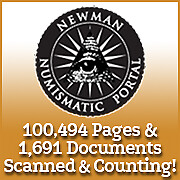
About UsThe Numismatic Bibliomania Society is a non-profit organization devoted to the study and enjoyment of numismatic literature. For more information please see our web site at coinbooks.org SubscriptionsThose wishing to become new E-Sylum subscribers (or wishing to Unsubscribe) can go to the following web page link MembershipThere is a membership application available on the web site Membership Application To join, print the application and return it with your check to the address printed on the application. Membership is only $20 to addresses in the U.S., $25 for First Class mail, and $30 elsewhere. For those without web access, write to: Terry White, Treasurer
AsylumFor Asylum mailing address changes and other membership questions, contact Terry at this email address: terrywhite5475@yahoo.com SubmissionsTo submit items for publication in The E-Sylum, just Reply to this message, or write to the Editor at this address: whomren@gmail.com BUY THE BOOK BEFORE THE COINSale Calendar |
- WAYNE'S WORDS: THE E-SYLUM JANUARY 31, 2016
- KARL MOULTON OFFERS NEW FIXED PRICE LIST
- NEW BOOK: LOST CENTS, DEAD OWNERS
- NEW BOOK: THE HELLENISTIC WORLD: USING COINS AS SOURCES
- NEW EBOOK: MEDALLIC ART OF THE ANS, 1865–2014
- NEWMAN PORTAL SCANS LARGE FORMAT CHAPMAN CATALOGS
- EX-NUMIS ENABLES COIN AUCTION SALE SEARCH BY IMAGE
- THE CDN PUBLISHING BLOG
- CSNS ANNOUNCES NUMISMATIC EDITOR’S FORUM
- 2ND LOOK: THE SECRET HISTORY OF THE FIRST U.S. MINT
- MORE ON AUTHOR BILL ANTON, JR.
- W. W. C. WILSON (1870-1924)
- THE DICKESON COPY OF THE SOMMERS ISLAND SHILLING
- NUMISTORICA ADDS THREE NEW PRESENTATIONS
- NOTES FROM E-SYLUM READERS: JANUARY 31, 2016
- ARTICLE PROFILES ANA ON ITS 125TH ANNIVERSARY
- WHERE HAVE ALL THE SHIELD NICKELS GONE?
- HOW PHOTO PRESENTATION AFFECTS COIN VALUES
- DICK JOHNSON'S PREDICTIONS FOR THE FUTURE OF NUMISMATICS
- CLEARING HOUSE CERTIFICATES AND THE PANIC OF 1907
- THE D. BRENT POGUE COLLECTION PART III: AN APPRECIATION
- THE COUNTERFEITING OF U.S. GOLD COINS AFTER WWII
- 2016 ANS GALA PHOTOS
- COINWEEK INTERVIEW WITH HARLAN J. BERK
- CNG’S TRITON XIX REALIZES OVER $26 MILLION
- DERBYSHIRE EDWARD III QUARTER NOBLE TO BE SOLD
- GORNY & MOSCH SPRING 2016 AUCTIONS 236-238
- SELECTIONS FROM THE STACKS-BOWERS FEBRUARY 2016 RARITIES SALE
- THE SOUTH AFRICA MEDAL
- CANADA'S LIBRARY OF PARLIAMENT COIN
- BANKNOTES OF THE BAHAMAS
- ANOTHER PHYSICAL BITCOIN PRODUCT
- BLOOKS: THE ART OF BOOKS THAT AREN’T
- TREASURE SEARCH TURNS INTO HUNT FOR SEARCHER
- CASH FOR YOUR WARHOL
- THE UAE KFC GOLD COIN GIVEAWAY
- HIGHLAND MINT STRIKES SUPER BOWL 50 COINS
- FEATURED WEB SITE: MUSEUM OSCAR ROTY
Click here to access the complete archive
To comment or submit articles, reply to whomren@gmail.com
WAYNE'S WORDS: THE E-SYLUM JANUARY 31, 2016

New subscribers this week include: Lou Soren. We now have 1,926 subscribers.
This week we open with Karl Moulton's return to the numismatic literature business, three new books, new digitized catalogs from the Newman Numismatic Portal, and a new business using images to search a catalog database for matches.
Other topics include W. W. C. Wilson, Harlan Berk, Bill Anton, Jr., Stanley Apfelbaum, Dickeson copies, Oscar Roty, Clearing House certificates, the 1943-S copper cent, auction sales, physical bitcoins, the South Africa medal, and predictions of the numismatic future.
To learn more about how coins decay, the Bushnell bid book, the CDN publishing blog, the CSNS Numismatic Journalists’ Forum, coin-collecting farmers, the Edward C. Rochette Money Museum, the unique Stater of Pharnakes I, the Royal Canadian Mint's new coin honoring the Library of Parliament, and Tales of the Greatest Coin Robberies, read on. Have a great week, everyone!
Wayne Homren
Editor, The E-Sylum
KARL MOULTON OFFERS NEW FIXED PRICE LIST
After a multi-year hiatus, Karl Moulton is returning to the numismatic literature business. His latest fixed price list has just been published. He writes:
This is the first list I've put out after a 2 1/2 year hiatus. During that time. I have moved to the historic town of Tombstone, Arizona. That's right, the place where the gunfight at the OK Corral took place in October 0f 1881.
With the departure of David Sklow from the literature arena, I figured it was a good time for me to re-enter the business.
Karl adds:
I'll be happy to send anyone who wants one, a complimentary list, free for the asking. They simply need to send me their contact information (as I will be updating the mailing list).
Welcome back! Karl can be reached at:
Karl Moulton
E. 2584 Colt Rd.
Tombstone, AZ 85638

NEW BOOK: LOST CENTS, DEAD OWNERS
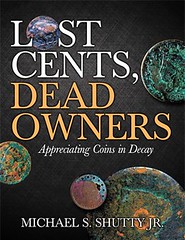 LOST CENTS, DEAD OWNERS: Appreciating Coins in Decay, by Michael Shutty, Jr. Published by Wasteland Press. ISBN:
978-1-68111-090-5.
LOST CENTS, DEAD OWNERS: Appreciating Coins in Decay, by Michael Shutty, Jr. Published by Wasteland Press. ISBN:
978-1-68111-090-5.
This is a book that I always wanted to read. But no one dared to write it. After a long wait, I decided to do it. I think folks will enjoy this one, as it is a celebration of coin collecting for the armchair historian. This book will appeal to anyone who has marveled at a crusty old coin found in the dirt or behind the hutch.
From the start, the title – Lost Cents, Dead Owners – lets you know that this is a no-nonsense book. It presents a familiar viewpoint with a twist: “A (lost) coin is history in your hand.” Such musings have unfortunately become lost in a coin marketplace that is obsessed with high-grade, high-value coins.
This book opens with the argument that corroded coins are fascinating relics that deserve to be collected. Early on I challenge the reader to appreciate the beauty of verdigris and other colorful products that signal when a coin is returning to nature. Like all great art, I suggest that the evocative impact of corrosion finds its energy in the darker emotions associated with loss, decay, and death.
This aesthetic is not new, as classical writers have remarked on the splendor, and romance, of ruins – from Roman temples to early American plantations. Charles Dickens called it an “awful beauty.” Other writers have claimed that many ruins are more beautiful now than when newly built. Indeed, the aesthetics of decay are shaped by the conflict between nature and the object wherein the object is losing. I submit that relic coins are ruins that we can hold in our hand.
This book also provides an in-depth tutorial on how copper and copper-nickel coins corrode. The minerals that accumulate on the surface of decaying cents and nickels are described. In addition, the electrochemical processes wherein electrons are stolen and the metal is eaten away are explained in plain language. No other coin book covers this material as well. Color photographs throughout the text illustrate the corrosive processes at work – I think the reader will find that the coins shown are spectacular.
This book suggests several strategies for collecting relic coins. In particular, I introduce the idea of contextual collecting. This approach uses archeological finds as a guide to selecting relic coins that reflect those found at specific historic sites. Imagine how fun it would be to collect the same coins actually dug from a Civil War battlefield or discovered in a colonial house. This contextual approach is contrasted with the mundane date-and-mint ritual that has shaped collecting since Victorian times.
I conclude the book by providing guidelines for selecting relic coins with original surfaces. You may be surprised to learn that unscrupulous dealers try to create a relic-look with household chemicals. Also, tech-savvy folks doctor their on-line photographs to make their coins look more alluring. I will show you how to avoid these deceptions.
This soft-cover book is a slim volume at 80 pages, but it is filled with ideas that you will not find elsewhere. It is an introspective book for the true collector – a great weekend read. The references cited range from the classics to geology to spectroscopy, and of course, numismatics. The format is large at 8.5 x 11. All the photographs are in vivid color. The book is available for $24.95 from Books123.org. Also, please check out the book information on my Google blog: oldcoinnecromancer.blogspot.com.
For more information, see:
Lost Cents, Dead Owners Book
(http://oldcoinnecromancer.blogspot.com/2016/01/lost-cents-dead-owners-book.html)
NEW BOOK: THE HELLENISTIC WORLD: USING COINS AS SOURCES
From the American Numismatic Society's January 2016 Enews:
Cambridge University Press (CUP), in partnership with the ANS, recently published The Hellenistic World: Using Coins as Sources, by Peter Thonemann. It is the first book in a new CUP series, Guides to the Coinage of the Ancient World, initiated by Dr. Andrew Meadows for intended use in university undergraduate and graduate ancient history, Classics, and archaeology classes.
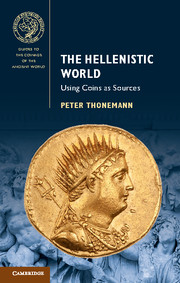 The Hellenistic World
The Hellenistic World
Using Coins as Sources
Part of Guides to the Coinage of the Ancient World
AUTHOR: Peter Thonemann
PUBLICATION PLANNED FOR: February 2016
AVAILABILITY: Not yet published - available from February 2016
FORMAT: PaperbackISBN: 9781107451759
Coinage is one of our key sources for the rich and fascinating history of the Hellenistic world (323–31 BC). This book provides students of the period with an up-to-date introduction to Hellenistic gold, silver and bronze coins in their cultural and economic contexts. It also offers new perspectives on four major themes in contemporary Hellenistic history: globalisation, identity, political economy and ideology. With more than 250 illustrations, and written in a lucid and accessible style, this book sheds new light on the diverse and multicultural societies of the Hellenistic world, from Alexander to Augustus. The author assumes no prior knowledge of Hellenistic history, and all Greek and Latin texts are translated throughout.
- Provides the only up-to-date introduction to this period of ancient Greek coinage
- Analyses Hellenistic coinage in its historical contexts, showing historians how to use coins as evidence for political, economic and cultural history
- Includes more than 250 photographs of Hellenistic gold, silver and bronze coins, presenting a vivid and attractive 'visual essay' on Hellenistic coins
For more information, or to order, see:
The Hellenistic World Using Coins as Sources
(www.cambridge.org/us/academic/subjects/classical-studies/ancient-history/hellenistic-world-using-coins-sources?format=PB&isbn=9781107451759)
NEW EBOOK: MEDALLIC ART OF THE ANS, 1865–2014
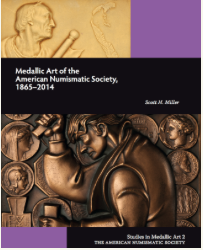 In anticipation of launching 89 titles as part of the Mellon Foundation-funded Humanities Open Book project, the ANS completed a
proof-of-concept, open access publication based on Medallic Art of the American Numismatic Society (by Scott Miller, 2015). The digital
edition is now freely available in mobi and epub formats (for tablets and mobile devices) through Internet Archive, and can be read via the ANS’s new
Digital Library. A handful of print copies remain available for purchase.
In anticipation of launching 89 titles as part of the Mellon Foundation-funded Humanities Open Book project, the ANS completed a
proof-of-concept, open access publication based on Medallic Art of the American Numismatic Society (by Scott Miller, 2015). The digital
edition is now freely available in mobi and epub formats (for tablets and mobile devices) through Internet Archive, and can be read via the ANS’s new
Digital Library. A handful of print copies remain available for purchase.
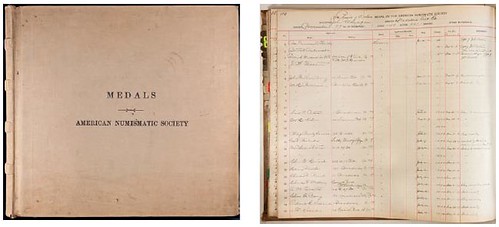
ANS Medal Sales Ledger Book
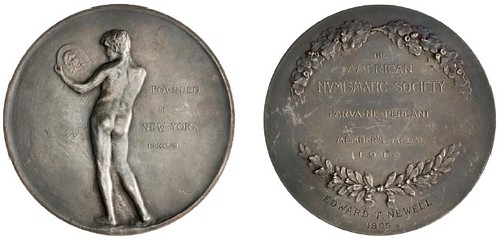
Silver membership medal of Edward Newell
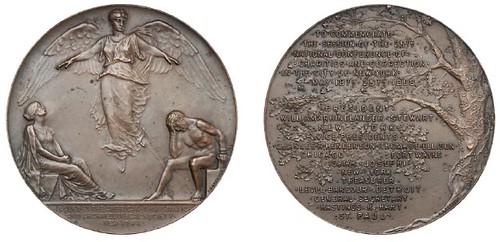
National Conference of Charities and Correction Medal (1898)
To read the ANS Digital Library version, see:
http://numismatics.org/digitallibrary/id/Miller-ANS-Medals
To purchase a print copy, see:
http://numismatics.org/Store/ANSMedals
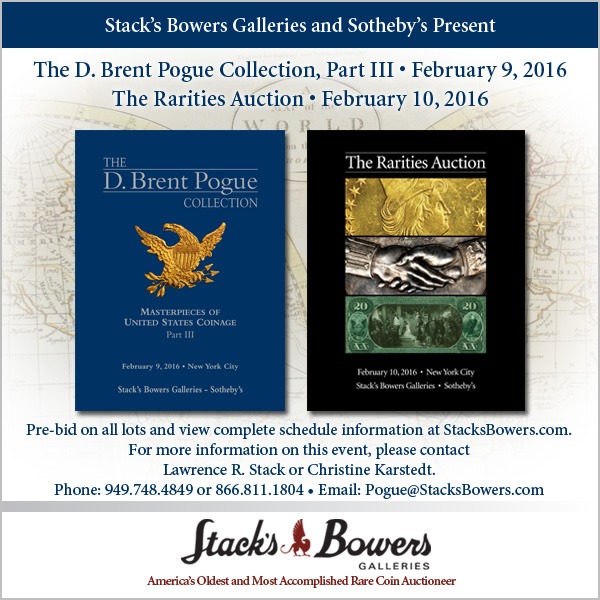
NEWMAN PORTAL SCANS LARGE FORMAT CHAPMAN CATALOGS
Newman Numismatic Portal Scans Large Format Chapman Catalogs
From the Hamelberg Library
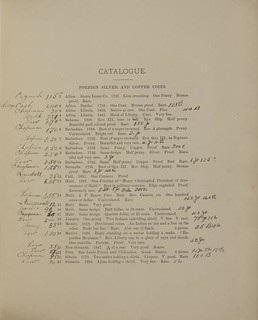 The Newman Portal has added a number of large format catalogs from the auction firms of Samuel H. and Henry Chapman. Combined with previous
loans from Dan Hamelberg, the Portal now has over 120 of the 161 Chapman sales listed in Martin Gengerke’s American Numismatic Auctions.
Included in this latest addition is a named and priced copy of the Stickney sale (1907), and the cataloger’s opening remarks resonate to the present
time. “This celebrated collection has for many years been a mystery, as hardly any one of the present generation had seen anything of it…” wrote
Henry Chapman, and today we similarly relate to the unveiling of collections quietly formed over a long period of time.
The Newman Portal has added a number of large format catalogs from the auction firms of Samuel H. and Henry Chapman. Combined with previous
loans from Dan Hamelberg, the Portal now has over 120 of the 161 Chapman sales listed in Martin Gengerke’s American Numismatic Auctions.
Included in this latest addition is a named and priced copy of the Stickney sale (1907), and the cataloger’s opening remarks resonate to the present
time. “This celebrated collection has for many years been a mystery, as hardly any one of the present generation had seen anything of it…” wrote
Henry Chapman, and today we similarly relate to the unveiling of collections quietly formed over a long period of time.
The Bushnell bid book (1882) is also here, the definitive record of one of the most important sales in American numismatics. Included as well are Mills (1904), Zabriskie (1909), Earle (1912), Jackman (1918), and others, many priced and named. John Ford, Jr. wrote in the August 1950 Numismatist “A complete set of the large size Chapman catalogs belongs in any numismatic library worthy of the name.” Most of our libraries fail by that standard, so we extend thanks to Dan Hamelberg for making this a virtual possibility to anyone with an Internet connection
To read the Chapman catalogs in the Newman collection on Internet Archive, see:
https://archive.org/details/newmannumismatic?and%5B%5D=chapman
EX-NUMIS ENABLES COIN AUCTION SALE SEARCH BY IMAGE
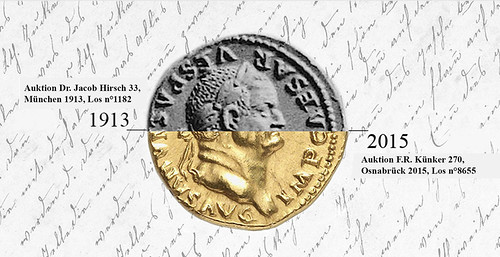
Do you know which collection your coin is from?
Ex-Numis®, a new website, can answer an important question: Has your coin been published at an auction? Instead of looking through thousands of auction catalogues, you can now send a request to www.ex-numis.com.
In the last years it has become more and more important to know a coins’ pedigree. On the one hand there are legal requirements, which ask for due diligence. On the other, coins deriving from large, historical collections realize higher prices, compared to coins with no known provenance. Until now, the only thing to do, in order to find out from which collection, that is auction the coin stems from, was to go through thousands of auctions catalogues. A new online tool by Ex-Numis® is now available for collectors, museums and coin dealers, which can be used to look for provenances.
Dr Jonas Flueck, a young scholar with a lot of experience in the coin auction business, is the founder of this website. With the help of an image recognition program, the tool compares images fed into the system to an extensive database. The material for comparison is exceptional: the database contains almost a million images of ancient coins and is constantly expanded. The images come from auction catalogues starting in the 19th century up to 2000. The clients’ coin will be compared to images from auction catalogues such as Ars Classica, Otto Helbing, MMAG, Ratto, Rolin & Feuardent and many more.
The best: It doesn’t cost a fortune to get your collection checked. Go to www.ex-numis.com to get more information. For anybody who wants to try out Ex-Numis® we are currently providing an introductory offer: Newly registered clients instantly receive 25 credits and can send in their images. The Ex-Numis® staff will then compare your images to the database and will let you know, if there is a direct hit and your piece derives from a large, renowned collection.
Ex-Numis® makes hours of searching for provenances in old catalogues become redundant and offers you more time to marvel and enjoy the beauty of your coins.
You can find the website under the following address: www.ex-numis.com. If you’d like additional information, please write us an email under: info[at]ex-numis.com or give us call at 0041 / 76 / 706 18 19.
I wouldn’t trust a computer alone on a task that has to be so precise, so I'm not surprised that they've kept humans in the loop. But it could be a big timesaver in narrowing down a set of possible matches for humans to review. Joel Orosz mentioned another roadblock, writing "It'll be interesting to see how they plan to correct for the use of 'stock' images, which we know were used all too often in the past." -Editor

THE CDN PUBLISHING BLOG

E-Sylum contributor Patrick Ian Perez is Editor of the Coin Dealer Newsletter. He writes:
The CDN Publishing blog can be found at blog.greysheet.com . In it we post all of the articles that we write for the Greysheet, Bluesheet, Greensheet, Monthly Supplement, and Quarterly issues. We also post news and other short articles that don't appear in our publications.
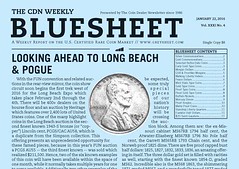 One of the many highlight coins in the Long Beach auction is the second finest known 1943-S bronze (or “copper”) Lincoln cent, PCGS/CAC
AU58, which is a duplicate from the Simpson collection. This offering presents an unprecedented opportunity for these famed pieces, because in this
year’s FUN auction a PCGS AU55 -- the third finest known -- was sold which realized $211,500. Hence, two of the six known examples of this coin will
have been available within the space of one month, while it normally takes multiple years for one to come available. Additionally, two other examples
of the six have never been offered at public auction according to the roster of known examples. Another exciting coin to be offered in the Long Beach
auction is the Eliasberg/Gardner 1892-O Barber half dollar, graded NGC/CAC MS68. This wonderful coin is tied with two others as the finest known of
this date.
One of the many highlight coins in the Long Beach auction is the second finest known 1943-S bronze (or “copper”) Lincoln cent, PCGS/CAC
AU58, which is a duplicate from the Simpson collection. This offering presents an unprecedented opportunity for these famed pieces, because in this
year’s FUN auction a PCGS AU55 -- the third finest known -- was sold which realized $211,500. Hence, two of the six known examples of this coin will
have been available within the space of one month, while it normally takes multiple years for one to come available. Additionally, two other examples
of the six have never been offered at public auction according to the roster of known examples. Another exciting coin to be offered in the Long Beach
auction is the Eliasberg/Gardner 1892-O Barber half dollar, graded NGC/CAC MS68. This wonderful coin is tied with two others as the finest known of
this date.
It is also not too early to begin discussion of the third installment of the D. Brent Pogue collection, which is to be sold by Stack’s Bowers and Sotheby’s on February 9th in New York City. Part 3 includes the collection’s half cents of 1793-97, large cents of 1793, capped bust dimes, a continuation of the capped bust half dollars from part 2, the three dollar gold set, and head left half eagles. As to be expected, some truly special pieces of our nation’s history will be crossing the auction block. Among them are: the ex-Missouri cabinet MS67RB 1794 half cent, the Atwater-Eliasberg MS67RB 1796 No Pole half cent, the Garrett MS65RB 1793 Chain cent, and the Norweb proof 1825 dime.
There are five proof capped bust half dollars: 1825, 1827, 1832, 1833, 1836, an amazing offering in itself. The three dollar gold set is filled with rarities as well, starting with the finest known 1854-D, graded MS62. Incredible also is the MS68 1863, the shimmering 1871 graded MS67, and a wonderfully toned 1877 graded MS64+. Although all of 19 half eagles are highlights in their own right, the presence of two MS67 (one MS67+) 1807’s, and the ultra-rare 1815, graded MS65 and off the market since 1982.

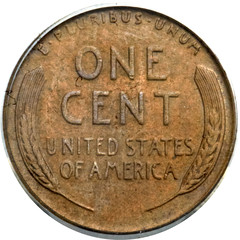
To read the complete lot description, see:
1943-S
1C Struck on a Bronze Planchet
(http://coins.ha.com/itm/lincoln-cents/small-cents/1943-s-1c-struck-on-a-bronze-planchet-au58-pcgs-secure-cac/a/1232-3087.s)
To read the complete article, see:
Bluesheet: LOOKING AHEAD TO LONG BEACH &
POGUE (http://blog.greysheet.com/2016/01/20/bluesheet-looking-ahead-to-long-beach-pogue/)

CSNS ANNOUNCES NUMISMATIC EDITOR’S FORUM
Announces Numismatic Journalists’ Forum
The 77th Anniversary Convention of the Central States Numismatic Society, scheduled for April 26-30, 2016, with bourse dates from April 27-30, will include a Numismatic Editor’s Forum and Workshop from 10:30AM-12:30PM on Thursday, April 28.
Moderated by CSNS Centinel Editor Gerald Tebben, the forum will include a panel made up of Steve Roach, Coin World Editor-at-Large; Beth Deisher, a past Coin World Editor; Wayne Homren, Editor of the E-Sylum, weekly electronic newsletter of the Numismatic Bibliomania Society, and Dave Harper, long time Editor of Numismatic News.
The forum participants will give the audience their perspectives on the evolving nature of numismatic journalism, the special challenges presented by covering a specialty marketplace, the impact of the internet on numismatic journalism and other topics that the audience may want to explore in a question and answer period to follow the panelists’ remarks.
Bruce Perdue, President of the Central States Numismatic Society, said, “Mainstream journalism, including newspaper and magazine publishing, have been significantly impacted by the growing importance and presence of the internet in our society. This forum will give the panelists an opportunity to educate our attendees on how such trends have affected their own specialty area of news coverage and commentary. While the forum will appeal to the wider audience that attends of convention, we especially hope that it will afford a chance for people who may be involved in the publication of newsletters for their local, state and regional numismatic organizations to interact with professionals in the field and take away information that will enhance and improve their own products.”
Perdue continued, “While people typically think of our Heritage auctions and our 300+ booth bourse area when our event comes to mind, we are really a whole lot more than just a big coin show. We strive to provide learning opportunities for our attendees that will enhance their involvement in the field and generally go beyond the core commercial aspects of numismatic. CSNS is about learning and knowledge. Our Numismatic Editors’ Forum and Workshop is an example of this commitment.”
The CSNS convention site is located in the Northwest Chicago suburb of Schaumburg at 1551 North Thoreau Drive, roughly ten miles from O’Hare Airport. Complete schedule and hotel reservation details are available on the organization’s website, www.centralstates.info. Patricia Foley, Bourse Chairman for the convention, is in charge of booth sales to dealers. She can be reached at foleylawoffice@gmail.com.
For more information about CSNS and the show, see:
www.centralstates.info
2ND LOOK: THE SECRET HISTORY OF THE FIRST U.S. MINT
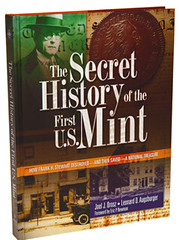 In an article published January 28, 2016 in Coin Update, Dennis Tucker of Whitman Publishing revisits a fine numismatic book -
The Secret History of the First U.S. Mint by Joel Orosz and Len Augsburger. Here's an excerpt. -Editor
In an article published January 28, 2016 in Coin Update, Dennis Tucker of Whitman Publishing revisits a fine numismatic book -
The Secret History of the First U.S. Mint by Joel Orosz and Len Augsburger. Here's an excerpt. -Editor
It seems like just yesterday, but it’s been almost five years! On January 6, 2011, at the Florida United Numismatists (FUN) Show in Tampa, Whitman Publishing released The Secret History of the First U.S. Mint: How Frank H. Stewart Destroyed—And Then Saved—A National Treasure. The 336-page hardcover would go on to win the prestigious “Book of the Year” award from the Numismatic Literary Guild.
If you haven’t read Secret History yet, head to your favorite bookseller or visit your local library; you can also borrow it for free from the Dwight N. Manley Numismatic Library if you’re a member of the American Numismatic Association.
This remarkable tale is ripped from the headlines of early 20th-century Philadelphia, and Frank H. Stewart is both its hero and its villain. Stewart was a study in contrasts: a high-school dropout who wrote the definitive history of our nation’s first coin factory; by no means an art connoisseur, and yet he commissioned famous artists to paint unforgettable images of the first U.S. Mint. A poor boy made good, Stewart bought the old Mint, labored to preserve it, and failed in the most dramatic way possible. Could his later acts of commemoration redeem his failures in preservation?
The Secret History of the First U.S. Mint tells, for the first time, the full story of the paradoxical Frank H. Stewart and his self-appointed life’s mission to celebrate an irreplaceable slice of Philadelphia’s—and our nation’s—heritage. It’s a tour-de-force work of scholarship that sets straight long-misunderstood Mint history.
Award-winning authors Joel Orosz and Leonard Augsburger filled their manuscript with dozens of sketches, paintings, and photographs of the first Mint that have been preserved in archival collections for decades, and hadn’t been seen by living numismatists until Secret History was published.
To read the complete article, see:
Exploring the Secrets of the First Philadelphia
Mint (http://news.coinupdate.com/exploring-the-secrets-of-the-first-philadelphia-mint/)
To read earlier E-Sylum articles, see:
NEW BOOK: THE SECRET HISTORY OF THE FIRST U.S. MINT
(www.coinbooks.org/esylum_v13n49a04.html)
BOOK REVIEW: THE SECRET HISTORY OF THE FIRST U. S. MINT
(www.coinbooks.org/esylum_v14n15a04.html)
BOOK REVIEW: THE SECRET HISTORY OF THE FIRST U.S. MINT
(www.coinbooks.org/esylum_v14n17a07.html)
THE BOOK BAZARRE
MORE ON AUTHOR BILL ANTON, JR.
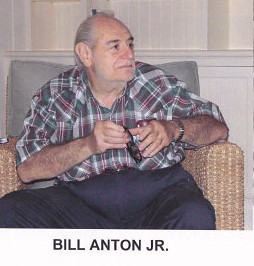 The E-Sylum reported on the death of William T. Anton, Jr. in the issue of August 16, 2015. No obituary was mentioned. I tried on a
couple of occasions to find one without success. He is not listed in the Social Security Death Index. I recently came upon additional information
about Anton.
The E-Sylum reported on the death of William T. Anton, Jr. in the issue of August 16, 2015. No obituary was mentioned. I tried on a
couple of occasions to find one without success. He is not listed in the Social Security Death Index. I recently came upon additional information
about Anton.
In the summer of 2015, Anton was drafting a new will with his estate to be distributed equally among his three children. He had an appointment in the afternoon of July 15 to meet his son-in-law and sign the papers with his attorney. He did not show up for the meeting, He died at home earlier in the day.
Anton was born in 1935. He graduated from Villanova University in 1957 and Harvard Business School in 1959. He operated Worldwide Promotions, Inc. for amateur and professional boxing.
In 1956 he competed as a weightlifter at the Olympic Games in Melbourne. He placed fourth with a benchpress of 440 lbs. Afterward he was known as “Mr. 400”.
Anton collected high quality colonial coins and specialized in the coinage and paper money of New Jersey. He contributed articles on the topic to The Colonial Newsletter. Others who know him offered their recollections in previous editions of The E-Sylum.
To read the earlier E-Sylum articles, see:
BILL ANTON HAS PASSED (www.coinbooks.org/esylum_v18n33a06.html)
MORE ON AUTHOR BILL ANTON, JR. (www.coinbooks.org/esylum_v18n34a18.html)
W. W. C. WILSON (1870-1924)
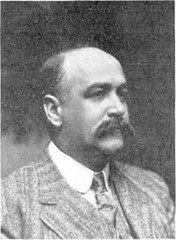 William Walter Coulthard Wilson (1870-1924) was born in November 1870, the son of an Irish Presbyterian immigrant to Canada, James Crockett
Wilson (1841-1899), and Jeanne Kilgour Wilson (1840-1897), at Montréal, Québec, Canada. His father established the paper manufacturing company in
1870 at Montréal.
William Walter Coulthard Wilson (1870-1924) was born in November 1870, the son of an Irish Presbyterian immigrant to Canada, James Crockett
Wilson (1841-1899), and Jeanne Kilgour Wilson (1840-1897), at Montréal, Québec, Canada. His father established the paper manufacturing company in
1870 at Montréal.
In October 1907 he joined the A.N.A. and is member No. 899. He joined the ANS on June 11, 1908. About this time he purchased en mass the collection of Louis Joseph Casault upon his retirement from the Library of the Canadian Parliament. Casault owned one of the finest collections of Canadian coins. Pierre N. Breton acted as the purchasing agent for Wilson of the entire collection. He was a charter member of the New York Numismatic Club in 1909. He attended the August 1909 ANA convention held at Montreal. In 1909 he joined the British Numismatic Society.
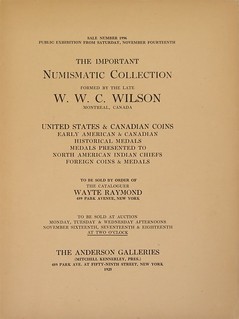 He was the First-Vice President of the ANA in 1910. He purchased The Numismatist from Farran Zerbe on October 12, 1910 with a
deposit of one cent paying the balance of $500.00 no later than December 31, 1910. Wilson entrusted the conveyance of The Numismatist to the
ANA to Howland Wood in a document drafted and signed on letterhead of the Hotel Thorndike, Boston, Massachusetts, on October 27, 1910. He donated the
magazine to the ANA as its official bulletin. The first official issue of the magazine as the property of the ANA was January 1911. Albert Romer Frey
was the first Editor.
He was the First-Vice President of the ANA in 1910. He purchased The Numismatist from Farran Zerbe on October 12, 1910 with a
deposit of one cent paying the balance of $500.00 no later than December 31, 1910. Wilson entrusted the conveyance of The Numismatist to the
ANA to Howland Wood in a document drafted and signed on letterhead of the Hotel Thorndike, Boston, Massachusetts, on October 27, 1910. He donated the
magazine to the ANA as its official bulletin. The first official issue of the magazine as the property of the ANA was January 1911. Albert Romer Frey
was the first Editor.
His coin collection was one of the finest of Canadian coins known and was cataloged by Wayte Raymond and sold posthumously by the Anderson Galleries on November 16-18th, 1925.
To read the complete article, see:
WILSON,
WILLIAM WALTER COULTHARD
(https://sites.google.com/site/numismaticmallcom/encyclopedic-dictionary-of-numismatic-biographies/wilson-william-walter-coulthard)
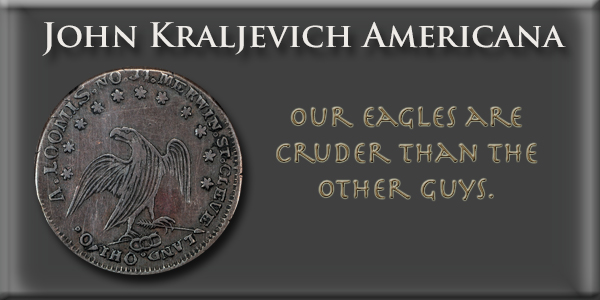
THE DICKESON COPY OF THE SOMMERS ISLAND SHILLING
Regarding David Pickup's Hogge money shilling, Jonathan Brecher writes:
That Sommer Islands piece is a modern tourist trinket, worth nothing,
Pete Smith writes:
I am attaching images of a Dickeson copy of the Sommers Island Shilling. It has a quality of detail not seen on the copy shown in last week's E-Sylum.
There are probably many differences in the dies. One that jumps out at me is on the reverse with the ship. Look at the line from the flag on the left to the flag at the center. On the Dickeson copy, it curves. On the E-Sylum copy it is straight.
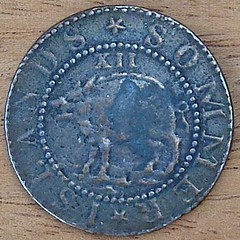
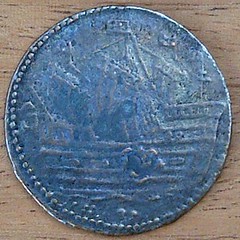
David Pickup's copy
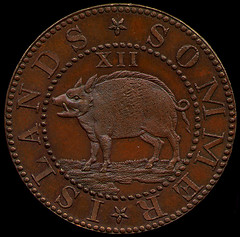
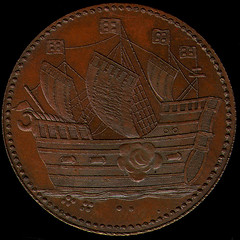
Dickeson copy
To read the earlier E-Sylum article, see:
NOTES FROM E-SYLUM READERS: JANUARY 24, 2016 : Query: Dickeson Copy of Sommers
Island Shilling? (www.coinbooks.org/esylum_v19n04a11.html)
NUMISTORICA ADDS THREE NEW PRESENTATIONS
When I created NumiStorica.com to provide free entertainment and education for coin clubs and advanced numismatists, I expected to cover a wide range of topics — and that is fairly evident in the most recent three postings” noted numismatic story-teller Bob Korver.
“Because of the superb images, these files are BIG. On the website, the new shows are broken into smaller “PDF” files for posting, but anyone — or any club — who contacts me can obtain a disk with complete versions (in one piece!): a QuickTime movie, a complete PDF version, original Apple Keynote versions, and a PowerPoint version. Computer compatibility for viewing and showing should not be a problem with this selection on the CDs.”
“JOHN HOWARD (1726-1790) Life Extraordinaire" (25 minutes) starts with a simple question which, unfortunately, is never answered to my satisfaction: what is the vignette of a English humanitarian focused on prison reform doing on a note of a Boston bank more than half a century later? An Englishman, I might add, who never visited America, although he toured all of Europe (and east through Russia) investigating prisons and plague houses. And a man so focused on his humanitarian efforts that he let his own finances deteriorate! Based on other evidence from a century later, I argue a certain connection with banking; I just don't have a clue what that connection is. Perhaps viewers can explain it?
“CORAZON AQUINO (1933-2009); A Peek Behind The Curtain of the 1986 Aquino-Reagan Coins" (15 minutes) For a very short time, I worked at the Franklin Mint. The highlight of that peculiar experience was being part of the team that produced the 1986 Philippine coins commemorating the historic first meeting between President Aquino and President Reagan. The silver and gold paired issues were produced in record time by a team of craftsmen who had very little motivation except pride of workmanship.
“BEEHIVES" (12 minutes) Mention beehives to any intermediate numismatist, and you will probably get the immediate response: "Mormon Gold". True enough, but our eons of relationship with the bee -- and the free housing we provide, the beehive -- has produced varied numismatic evidence through time and around the world. Not surprisingly, every artist has had to grapple with the identical problem of scale (relatively speaking, hives are large, and bees are very small). Their depiction may be an apt metaphor; It’s their influence on humanity that's large!
The NumiStorica.com website won the coveted “Best Non-Commercial Website of 2015” award from the Numismatic Literary Guild at the Chicago ANA, with only the first three presententations; now there are ten, with dozens more planned.
The presentations were created in Apple Keynote as 'slide' shows. On the NumiStorica.com website, they are posted as .pdf files due to technical size issues. Coin clubs who wish to use them as their educational entertainment should email Korver at r.b.korver@NumiStorica.com AND telephone 214-244-5478. Disks containing many versions have been created (including QuickTime movies) and can be provided, or a link to the Keynote version on iCloud.com. Korver has volunteered to ‘phone in’ to meetings for questions and discussions.
Bob Korver can be contacted at r.b.korver@NumiStorica.com or 214-244-5478 for more details and notifications of upcoming additions to the website.
To visit the NumiStorica web site, see:
http://www.numistorica.com/

NOTES FROM E-SYLUM READERS: JANUARY 31, 2016
Ray Williams, Numismatic Supermodel
Dennis Tucker of Whitman Publishing writes:
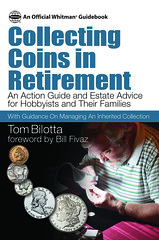 Keen-eyed readers of last Sunday’s E-Sylum have undoubtedly spotted the numismatic celebrity on the cover of Collecting
Coins in Retirement—none other than hobby stalwart Ray Williams.
Keen-eyed readers of last Sunday’s E-Sylum have undoubtedly spotted the numismatic celebrity on the cover of Collecting
Coins in Retirement—none other than hobby stalwart Ray Williams.
From the book’s copyright page: “Ray Williams, a colonial coin expert from Trenton, N.J., won third place in Whitman Publishing’s ‘Share Your Hobby’ photo contest with this image. The photo, taken by Ray’s wife Diane, shows Ray studying his collection at his desk. Appreciating one’s coins in such a manner, carefully weighing their emotional value versus the potential returns of their sale, and considering their significance as family heirlooms are all important tasks to undertake in retirement.”
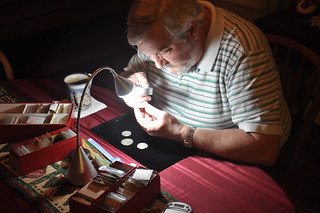
To read the earlier E-Sylum article, see:
NEW BOOK: COLLECTING COINS IN RETIREMENT
(www.coinbooks.org/esylum_v19n04a03.html)
Stanley Apfelbaum Photo
Speaking of photos of numismatic figures, Tom Harrison writes:
Many thanks for your efforts which certainly enhance our fine hobby. In the January 17th issue of The E-Sylum you requested a photo of Stanley Apfelbaum. I thought I would send one I found. It came from the July 1980 First Coinvestor / First Stampvestors Rare Coin And Stamp Advisory.
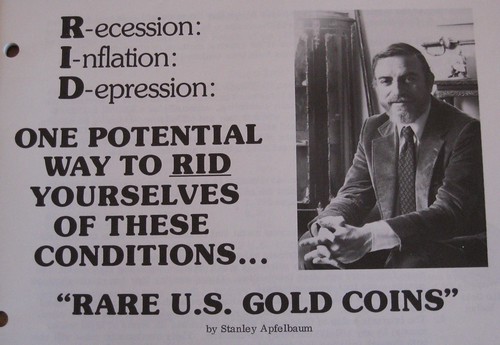
To read the earlier E-Sylum article, see:
COIN TELEMARKETING PIONEER STANLEY APFELBAUM
(www.coinbooks.org/esylum_v19n03a19.html)
Coin Collecting Farmers
Regarding Pete Smith's question about farmers who were coin collectors, George Kolbe writes:
Pete may be writing about Hiram E. Deats, the Philatelic [and Numismatic] Farmer from Flemington. In more recent times, Frank Van Zandt was a prominent farmer in Livonia, New York, whose 19th century family farmhouse was located on the eponymously named road where cattle were driven down to the river for transport.
Pete Smith writes:
My question was prompted by research I was doing on Robert H. Gore, Jr. (1908-2002). He started collecting coins at ten years old while a newsboy in Terre Haute, Indiana.
Gore graduated from Notre Dame in 1931 with a degree in agriculture. He operated a poultry and grain farm for fifteen years near Lake Zurich, Illinois. He married Margaret Powers and had five children.
In 1946 he moved to Florida to work with his father who was successful in insurance and the newspaper business. The son rose through the company until he was chairman of the board for the North American Company. I suspect that his interest in numismatics benefited from employment in a more lucrative field.
Bibliomaniacs may not be familiar with the Gore name because his collection did not sell at auction in a named sale. Who knows what happened to the Gore coin collection?
To read the earlier E-Sylum article, see:
NOTES FROM E-SYLUM READERS: JANUARY 24, 2016 : Query: Famous Farmer
Numismatists (www.coinbooks.org/esylum_v19n04a11.html)
ARTICLE PROFILES ANA ON ITS 125TH ANNIVERSARY
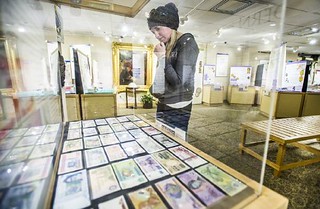 Money makes the world go round, and it's helped keep the Colorado Springs-based American Numismatic Association going for more than a
century.
Money makes the world go round, and it's helped keep the Colorado Springs-based American Numismatic Association going for more than a
century.
This year, the nonprofit organization that's devoted to the study of coins, paper currency, tokens, medals and other numismatics marks its 125th anniversary - a period that underscores the world's fascination with collectibles that are steeped in history and often reflect a country's culture and values, its officials say.
"It's just the passion of collecting and finding that treasure and studying it and learning about the history of how it was produced," said Kim Kiick, the association's executive director. "It's a wonderful hobby."
The Numismatic Association opened in 1967 at 818 N. Cascade Ave., just north of downtown and on the campus of Colorado College. The association leases the ground from the college for $1 a year, but owns its two-story building that houses its headquarters, the Edward C. Rochette Money Museum and the Dwight N. Manley library, Kiick said.
In Colorado Springs, the Numismatic Association museum's lower-level "history of money" exhibit includes displays of early Greek, Roman and Chinese coinage; paper money and coins from throughout U.S. history; examples of modern coinage from around the world; so-called "hobo nickels," in which the images of American Indians and buffaloes on nickels were transformed into miniature works of art; and even an explanation of counterfeiting.
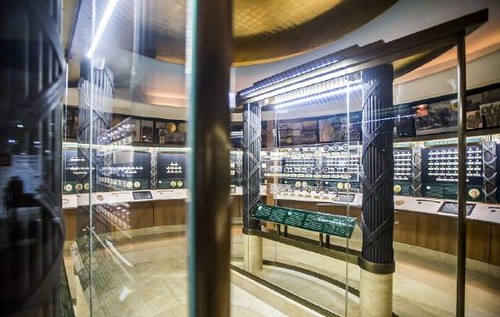
The museum's first floor includes the Harry W. Bass Jr. gallery, where hundreds of rare gold coins collected by the late Texas oilman, ski resort developer and philanthropist are on display as part of a long-term loan from the Harry W. Bass Jr. Foundation. Bass created "one of the most complete U.S. gold coin collections ever assembled, including many one-of-a-kind specimens," according to the association.
The display includes the only complete collection of $3 U.S. gold pieces - including one minted in San Francisco in 1870 that's the only one of its kind in existence. The display also includes a complete collection of U.S. gold coin types of all periods and designs from 1795 to 1933 and a rare grouping of U.S. pattern coins - proposed designs of coins that may or may not have been adopted for general circulation.
"For the general public, it's amazing to see so many gold coins," said museum curator Douglas Mudd, the former collection manager of the National Numismatic Collection at the Smithsonian Institution. "Most people forget that the U.S. did issue gold coins, because we haven't seen them for 70 or 80 years."
Other gee-whiz specimens on the museum's upper floor include a 1776 Continental dollar issued by the Continental Congress, a 1913 Liberty head nickel valued at $2 million and two of the 15 known 1804 dollars that are valued at a total of $6 million.
"You won't see that type of group anywhere else in the country on display right now," Mudd said. "It's pretty amazing to see it here in Colorado Springs."
Besides the museum, the association maintains what it says is the world's largest circulating numismatic library - more than 128,000 books, auction catalogs, periodicals, videos and slide sets. Association members can check out items to study their collectibles, although the public can only use research materials during visits to the library. A climate-controlled rare book room preserves and displays many of the library's most important reference works.
To read the complete article, see:
125 years
and counting for Colorado Springs-based American Numismatic Association
(http://gazette.com/125-years-and-counting-for-colorado-springs-based-american-numismatic-association/article/1568664)
THE BOOK BAZARRE
WHERE HAVE ALL THE SHIELD NICKELS GONE?
Where Did All Our Coins Go? A Numismatic Mystery
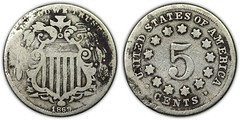 It is said that a curious mind is, well, er, a good thing, I guess.
It is said that a curious mind is, well, er, a good thing, I guess.
So a recent article by my friend Winston Zack in the John Reich Journal got me to thinking about the survival rate of our coins. Why are survival rates for coins so tiny?
For example, a survival rate of 3% is generally accepted for the early date large cents. And survival rates seem pretty consistent across dates and time periods.
That's a lot of missing coins – many billions of round metal objects, not all of which are made in precious metals or even made in easily reusable metals. Where do all of these “missing” coins go?
Were they melted?
OK – it is true that lots of coins have been melted over the years. That definitely happened to some US coins, to some extent. It happened
to large cents (largely in the 1850's) and to lots of silver and gold coins, for example. Fair enough.
So let's pick a coin struck a metal where there was no significant melting: nickel. I know of no one who has melted quantities of nickel coins to turn them into nickel alloy ingots for speculation or investment, for example.
And then lets pick a design: the Shield nickels made from 1866 through 1883.
There were 128 million shield nickels minted. Do even 5% of these survive? If so, that still means that several million shield nickels are still lying around somewhere.
If we say that 5% survived, that means 95% did not. That is over 120 million unaccounted for shield nickels. Every one of those little metal disks had to go somewhere.
Were the coins lost?
There were no major shipwrecks where millions of shield nickels were lost. I find it hard to believe that if someone walked home from the
store with 20 shield nickels in their pocket that by the time they arrived home 19 had been lost in the dirt. And that would have to be
done over and over and over again for them all to be “lost in the dirt”.
That is 660 tons of lost shield nickels since 1883. And that is just 1 design in 1 denomination made for less than 20 years in the 1800's.
The fact is – those 95% of shield nickels struck really did go somewhere. There is a right answer, or a right series of answers. I just don't know what those answers are. And thinking about it makes my head hurt.
To read the complete newsletter, see:
Making The Grade #25: A Coin Mystery Worthy of
Scully and Mulder; How Smart Phones Affect Coin Values
To visit Dave Wnuck's web site, see:
www.davewcoins.com
HOW PHOTO PRESENTATION AFFECTS COIN VALUES
How Smart Phones Affect Coin Values
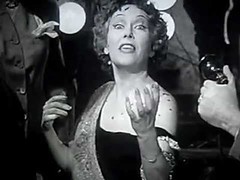 I was listening to a radio interview with the New York Times' food critic last week. He was describing how the recent practice
of diners taking pictures of their food with smart phones has drastically affected the restaurant business. Those photos are uploaded to social media
sites where millions of people view them and comment on them.
I was listening to a radio interview with the New York Times' food critic last week. He was describing how the recent practice
of diners taking pictures of their food with smart phones has drastically affected the restaurant business. Those photos are uploaded to social media
sites where millions of people view them and comment on them.
I thought it was an odd connection for him to make. But he went on to explain that food presentation has become significantly more important to the success of a restaurant in recent years. Chefs now spend a lot more time on how the dish will photograph and less time on how it actually tastes. The dish might be cold by the time it gets to you because they spent so much time arranging it, or it might not taste as good as it looks. But if it takes a good photo, often the restaurant will gain customers as a result.
As it is my custom to relate everything I see and hear to numismatics, here is how it looks to me through the prism of coin collecting. Turns out, we can clearly see ourselves in his comments.
Beautiful coins have always been popular. They have always sold for more than their ordinary looking brethren. However, these days that the really pretty coins – especially those that photograph well – are now by far the most desirable coins, and bring outsize prices at auction, via private treaty and on web sites such as my own.
In my own business, coins that may be solid and what I would consider to be desirable for what they represent often take an inordinately long the time to sell if they are not photogenic as well. Also, when I search for coins to buy at shows and at auction, I am now keenly aware of the way a coin will photographs before I buy, especially with pricier coins. I have passed on many coins that I thought were good values because I wasn't sure they would image well.
For me it has been trial and error over the years. For example a coin that has a light planchet streak almost invisible to the naked eye will often show up as a dark streak to the unblinking eye of the camera. Also, dark toning areas and spots normally look much worse in photos compared to the way they look in hand.
This influences my purchase decisions, and I have talked to many other dealers (especially those with web sites) that think the same way I do. There is no question this has affected the type of coins that people pay premiums for, and also the type of coins that end up selling for a discount.
This trend is neither good nor bad -- it just IS. But I don't recall anybody mentioning this factor in the past, so I thought I would do so (for the benefit of the for the four or so people who have read this far).
To read the complete newsletter, see:
Making The Grade #25: A Coin Mystery Worthy of
Scully and Mulder; How Smart Phones Affect Coin Values
To visit Dave Wnuck's web site, see:
www.davewcoins.com

DICK JOHNSON'S PREDICTIONS FOR THE FUTURE OF NUMISMATICS
Tom Kays' request for predictions on the future of coin collecting and numismatics is in itself insightful. Based on 75 years in the field, my credentials cover many aspects as a collector, dealer, observer. writer, even manufacture in the field. Are those qualifications enough to make these predictions? I have written about some of these predictions before, notably on future U.S. coins.
Therefore, in response to Tom's request here are my top twelve predictions for the future of numismatics...
1. The churning of rare coin sales at auctions among investors at ever increasing prices – like the Dutch tulip craze -- will someday bust. Prices will fall to a sustained level supported only by collector interest.
2. Before this happens an increasing number of new auction firms will be formed to serve the increased sales activity. Only the big four will survive.
3. Investors who were burnt because they did not liquidate their coin holdings will leave the field forever. Far-sighted investors who had liquidated their holdings will join others in acquiring bullion coins as their interests shifts to precious metal investing.
4. States which place a sales tax on bullion coins will find the sales of these within their borders fall to near zero. Entrepreneurs in tax free states will establish bullion coin depositories for out-of-state investors.
5. The United States will follow so many other countries in eliminating the issuing of low-value coins. The U.S will drop three coin denominations and add three new ones to accommodate the country’s ever-increasing economic growth. The cent, nickel and quarter will become obsolete where prices and sales transactions will be rounded off to the nearest tenth of a dollar. Five, ten and twenty dollar coins will be issued because of demand for coins for easier cash transactions at the higher amounts.
6. Numismatics with an obvious strong interest in coins will find an ally for those new denominations in the vending machine industry which will embrace the higher value coins to overcome their industry’s major problem – machines accepting paper currency. This includes. identification of currency denominations and high degree of paper money rejection.
7. Compositions of U.S. coins will change. The new dimes will be ceramic coated aluminum, half dollars will be copper, dollar coins will be brass similar to the Sacagawea dollar (which will continue to circulate and 30 million of these currently in storage will be released into circulation). Five-dollar coins will be copper-nickel, ten and twenty-dollar coins will be silver.
8. Three U.S. refineries (on East coast, West coast and Central U.S.) will contract with the Treasury Department to melt and reformulate the billions of cents withdrawn from circulation. The refineries will add virgin copper to the copper-coated zinc cent scrap for a new 95 copper 5 zinc composition. They will roll this new formulation in strips the gauge (thickness) of the new half-dollar coin. They will also blank the strips for the half-dollar coin blanks and ship these to the mints for upsetting and striking.
9. Withdrawn coins -- cents, nickels and quarters -- will be collected by banks and shipped by Brinks and other means. Cents go to refineries, nickels and quarters will go to Mints for melting, rolling and blanking into five-dollar coins. The volume of this will be staggering. Cents alone will not be measured in bags. or pallets, but in boxcars. It will take years to reformulate and strike new coins from withdrawn coins.
10. Collectors of current coins of the world will find fewer coins issued in the future by countries turning to a cashless economy, During Christmas week 2015 Sweden became the first country to announce it will no longer issue coins and currency. Sweden’s national bank, Riksbank, will accept deposits of coin and currency but no longer will pay out physical coins and paper money. All payments and transactions will be made by app or credit card. It’s no longer “paper or plastic” in Sweden.
11. To the wonder of old-time collectors, future collectors will study even more minutia of a coin’s surface. They will seek microscopes with greater power to catalog the characteristics of dents and scratches. They will seek more sensitive scales to determine the amount of wear on a coin, and in an attempt to establish numerical ratings within the Sheldon scale based in part on their weight (once proved impracticable by Coin World’s Amos Press Company).
12. The number of numismatic books on coins will gradually increase but will reach a point where all coins of the world, past and present, will have been covered, then drastically decease. In contrast, books on medallic topics will appear in increasing numbers, as collectors find more ways of collecting by new topics, from the current number of about 250 topics until this reaches over a thousand.
CLEARING HOUSE CERTIFICATES AND THE PANIC OF 1907
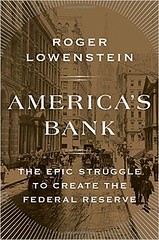 "By then, a new crisis was erupting: New York City was running desperately short of cash. ... New York's [trust banks] lost a
remarkable (and devastating) 48 percent of their deposits. Even worse, at the end of October the New York Clearing House was forced to take the
drastic step of authorizing banks to settle accounts with one another via certificates -- paper substitutes for money -- rather than with cash. The
Panic had now reached epic proportions. The Clearing House 'loan certificates' were backed by loans of the member banks. They were IOUs --
promises to pay cash when cash became available. They were a form of invented money.
"By then, a new crisis was erupting: New York City was running desperately short of cash. ... New York's [trust banks] lost a
remarkable (and devastating) 48 percent of their deposits. Even worse, at the end of October the New York Clearing House was forced to take the
drastic step of authorizing banks to settle accounts with one another via certificates -- paper substitutes for money -- rather than with cash. The
Panic had now reached epic proportions. The Clearing House 'loan certificates' were backed by loans of the member banks. They were IOUs --
promises to pay cash when cash became available. They were a form of invented money.
"With panic spreading, clearinghouses and bank associations in scores of other cities minted their own versions of clearinghouse money. Some were elaborately engraved to give the appearance of normal currency. The certificates were intended to be used only among banks, so that cash could be preserved for ordinary depositors. In a crude way, they added to the money supply -- later a function of the Federal Reserve. However, in more than a score of cities banks were forced to hand out loan certificates not just to their fellow banks, but to ordinary depositors.
"Many railroads, mining companies, and shopkeepers paid workers with bank checks instead of with cash; those that didn't had little choice but to suspend operations. In Birmingham, Alabama, banks distributed checks signed by their cashiers in denominations as small as one dollar to local employers -- who used this scrip to pay their workers. Retail establishments generally accepted such paper, since that was all that many customers had.
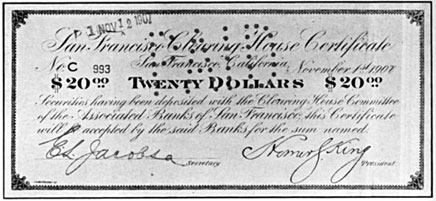
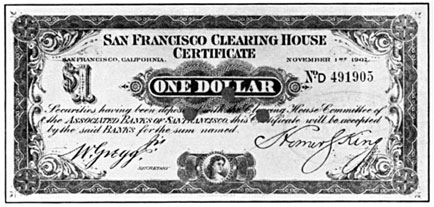
"By mid-November, approximately half of the country's larger cities were using loan certificates 'or other substitutes for legal money,' according to a survey conducted just after the Panic by Harvard's Professor Piatt Andrew. Loan certificates had been used in previous panics, but never so extensively. In some smaller towns where no clearinghouse existed, the local bankers improvised, setting up a temporary committee, as it were, on the front porch. Bankers tried to reassure the public, noting that certificates were backed by 'approved securities.' Some added piquant details. In Portland, Oregon, the clearinghouse boasted that banks had deposited notes secured by 'wheat, grain, canned fish, lumber . . . and other marketable products.' Monetary exchange was reverting toward barter.
"Andrew estimated that $500 million of cash substitutes of one form or another were circulated nationwide. And in two-thirds of cities with populations above 25,000, banks suspended cash withdrawals 'to a greater or less degree.' For example, in Council Bluffs, Iowa, a limit was imposed of $10 per customer; in Atlanta, $50 per day and $100 per week. Banks in Providence, Rhode Island, adopted a convenient policy of 'discretion,' vetting withdrawals case by case. Although such actions had scant legal footing, officials not only looked the other way, in many states they encouraged banks, for their own protection, to curtail teller operations. Bank holidays were proclaimed in a handful of states, with California's enduring until late December. Small wonder that Andrew termed it 'the most extensive and prolonged breakdown' of the credit system since the Civil War."
To read the complete article, see:
PRINTING MONEY, REALLY PRINTING MONEY -- 01/25/16
(http://delanceyplace.com/view-archives.php?p=2987)
For more information on the Panic Scrip book, see:
NEW BOOK: PANIC SCRIP OF 1893, 1907 AND 1914
(www.coinbooks.org/esylum_v16n43a05.html)
THE BOOK BAZARRE
THE D. BRENT POGUE COLLECTION PART III: AN APPRECIATION
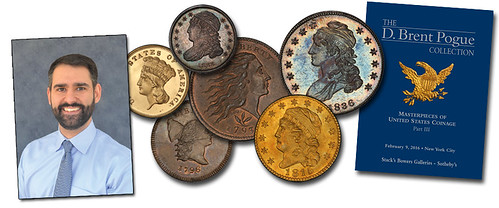
Coin collectors may not seem an especially reverent lot. Casual demeanors and good senses of humor are more commonplace than their opposites, from local coin shows to Manhattan auction galleries. The bourse floor is a leveler that puts experts and connoisseurs shoulder to shoulder with hobbyists of all levels. Proximity breeds familiarity, and most of today’s legendary collectors and experts are a coin-show handshake or an email away.
Our relationship to the great names of the past is more distant and less easily affirmed. We connect with the experts and collectors who have gone before us in three ways: the coins they owned or studied, the writings and photographs they left behind, and the still thriving numismatists of an earlier generation who knew them well. Their names are whispered. The books they wrote are prayerfully thumbed into disrepair or bound in rich leathers to preserve the words within. The coins they owned are cherished like talismans, their provenance extending a stamp of approval from the great beyond. Stories about their hijinks, or cabinets, or human foibles, are campfire tales wherever numismatists gather to break bread or find the bottom of a bottle.
While numismatists, in particular those who collect early United States coins, have a reverence for those who came before them, their reverence does not extend to themselves. The collectors of today tend not to be entirely self-conscious about their place in this historical continuum. The friends they visit at coin shows and afterward join for dinner are not acknowledged as VIPs whose biographies will be reconstructed by future researchers; they’re simply their friends. The prizes they find on bourse floors and in auctions are not considered future objects of research and inquiry, they are simply nice additions to their collections. And the catalogs they read may be viewed as sales tools, bound for the recycling bin, rather than works that will be studied by collectors not yet born.
Those who participate in the Pogue auctions are taking part in history. The collections and biographies of those who purchase these coins will be pondered, studied, and researched, long after all who knew them personally are gone. The coins bid upon in this sale will continue to be the focus of scholarly and collector interest, just as they were a century ago. Notes taken in the catalogs of those who view these coins or attend the sale will be scrutinized by future generations.
Out of reverence for the coins themselves, and for the place of this catalog in numismatic history, many people have assisted with the task of producing this catalog. Fellow researchers like P. Scott Rubin, Craig Sholley, John Dannreuther, Saul Teichman, Joel J. Orosz, Mike Spurlock, David Tripp, and W. David Perkins willingly and collegially shared the fruits of their labors, with no greater hope than to add to the published historical record. Others opened their libraries or probed the depths of their memories, helping to find tidbits published long ago but mostly forgotten or sharing recollections that have never before been put into print. Their respect for our predecessors in the pursuit of numismatic knowledge, for the past and present relationships that have carried these coins into the 21st century, and for the coins themselves has made this catalog a more useful reference, and I am thankful for all their assistance.
The half cents, cents, dimes, half dollars, and half eagles in this sale each tell a great story. I am proud to have been allowed to study each of them and honored to have been their mouthpiece as they come to auction.
To read the complete article, see:
The D. Brent Pogue Collection Part III, An Appreciation (www.stacksbowers.com/NewsMedia/Blogs/TabId/
780/ArtMID/2678/ArticleID/65561/The-D-Brent-Pogue-Collection-Part-III-An-Appreciation.aspx)
THE COUNTERFEITING OF U.S. GOLD COINS AFTER WWII

In the early days after World War II, as counterfeit coins were being made and entering the country, the Secret Service started confiscating and seizing false gold coins found in jewelry shops, pawn shops and even at some coin dealerships.
The agents went into shops, pretended to be buyers, asked what was available, and checked what they saw. If they felt something was a counterfeit they seized it, issued a pink slip as a receipt and took the items either to a qualified coin dealer or back to headquarters. Those who were selling counterfeits, even if the seller believed they were genuine, were indicted and received jail time as well as big fines.
During the 1950s counterfeit gold coins continued to flood the U.S. markets as well as world markets. Near the end of the 1950s the quantity was so great that Congress authorized the establishment of the Office of Gold and Silver Operations (OGSO) intensifying the confiscation of false gold coins. In fact, as the flow increased, President Kennedy authorized the office to institute regulations for licensing of all gold coin imports. In order to import any gold coin, one had to apply for an import license. After the license was received, one could request the import be sent and then the packages were open and compared to the license, counterfeits were removed and then the item could be imported. For all this to happen, the coins had to be genuine, they had to be considered rare and unusual by the Office, and only those that “qualified” according to the regulations were licensed.
The procedure was burdensome and difficult to adhere to, and the import of gold coins was slowed considerably. Actually, smuggling became quite common.
The main trouble was there was no list of what could be imported or what would be denied; the OGSO ruled individually on each coin that a license was to be issued for.
Most professional dealers, who needed to import gold coins, complied with difficulty, applying to get a license for each coin, and/or collection they wished to import. This procedure could be virtually impossible.
I offer one example to illustrate how this affected us at Stack’s. In 1963, a good client and friend of the firm, living in The Netherlands, decided he had to sell his collection, and move to a place like Arizona, for his health. He sent us a list of some 925 different gold coins of the world that he wanted to sell. He understood import and export regulations so he permitted us to apply using his list for the application. The major portion of the coins were of a classic nature, including ducats from the medieval era and choice and rare coins of the 17th, 18th, 19th and early 20th centuries. It would be a major collection for us to offer.
We took the list, filed it with the office in Washington and waited for a reply. After a month's time we inquired again and were advised it would be forthcoming. I had planned a trip to Europe to take place about two months after filing for the license, so that I could help our client pack and ship the coins to the United States. Thinking approval was imminent I left for Europe, calling my cousin Norman every day to see if the license had arrived. I stayed for over two weeks in Europe waiting for reply but none was received. The client said he would wait so he could sell the coins in America. About two months after my return, one of our foreign experts went to Europe in the hopes of assisting the client as soon as the license was received. After remaining in Europe for three weeks, the license had still not arrived and the expert came home.
Since dealing with a government agency requires a legal mind, I engaged Washington attorneys to manage the dispute. We took advantage of a Departmental hearing that took place in late 1966 as I recall. We won the case as it was determined by the official who heard the pleadings that the rulings in our case were arbitrary and capricious. Based on the facts that these were collector items -- rare coins -- the importation should be allowed. As is often the case, we won the battle, but lost the war.
For a few days we were happy to hear that the restrictions could be waived. The basic reason for the ruling in our favor was that the Office of Gold and Silver operations never sent or provided reason why denials occurred. However, about a week later, our attorneys got a letter from the Office that said, in effect, “Regardless of the ruling license for the collection is still denied.“ It was a shock to all of us, and we decided immediately to go to court and appeal the decision.
We had started to prepare the appeal when our attorneys heard that it would be advisable to hold back as some new rulings were forthcoming. At a PNG meeting in the fall of 1967 a government official from the Treasury Department, which had authority over the office, spoke to the gathering about the gold regulations.
In essence, his speech explained that as the intent of the import rules of 1961 had been satisfied, there was no further need for licensing of genuine gold coins of the world, with the exception of coins issued after the initial Gold Act of 1933/34, which still might need review. This was a win for all dealers, and one that would allow imports without red tape. As members of the numismatic community, and coin professionals in particular, we were very pleased that we no longer had to deal with the arbitrary and restrictive policies on importation.
However, it was a loss for Stack’s as the client became sick and required the funds for his proposed relocation in America, forcing him to sell his holdings in Europe.
To read the complete articles, see:
Counterfeiting and its Effects on Numismatics, Part Three (www.stacksbowers.com/NewsMedia/Blogs/TabId/780/ArtMID/
2678/ArticleID/65534/Counterfeiting-and-its-Effects-on-Numismatics-Part-Three.aspx)
Counterfeiting and its Effects on Numismatics, Part Four (www.stacksbowers.com/NewsMedia/Blogs/TabId/780/ArtMID/
2678/ArticleID/65554/Counterfeiting-and-its-Effects-on-Numismatics-Part-Four.aspx)
To read the earlier E-Sylum article, see:
THE COUNTERFEITING OF U.S. GOLD COINS AFTER WWII
(www.coinbooks.org/esylum_v19n01a16.html)
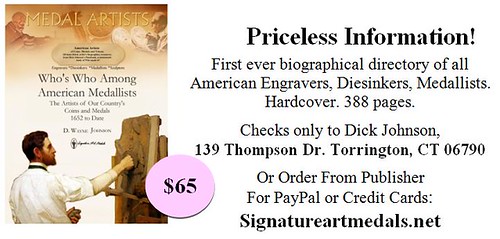
2016 ANS GALA PHOTOS
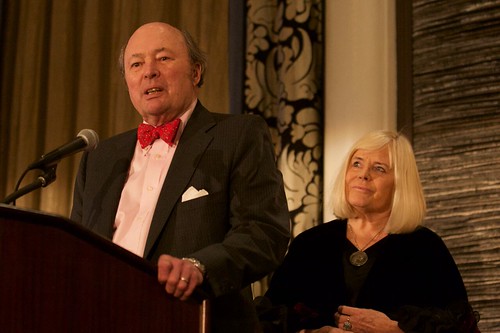
John and Regina Adams at the podium, accepting the Trustees’ Award
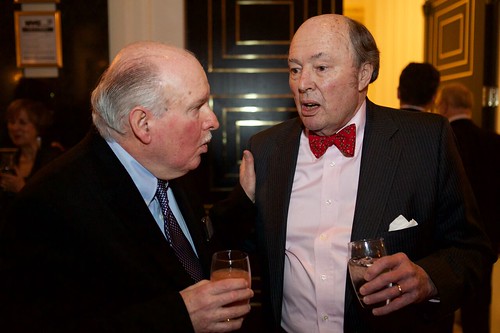
Former ANS Librarian Frank Campbell with John Adams
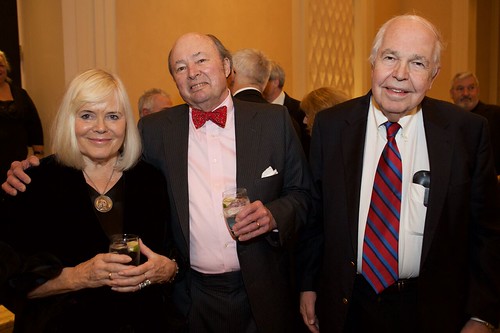
John and Regina Adams with Dave Bowers
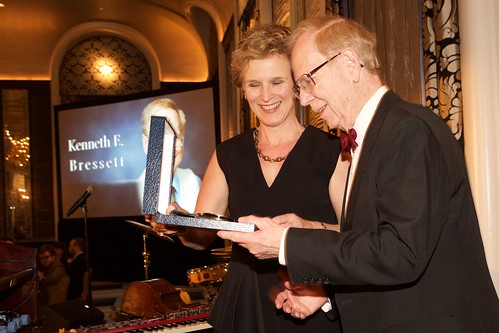
Ken Bressett receives his Distinguished Service Award from
ANS Executive Director Ute Wartenberg Kagan
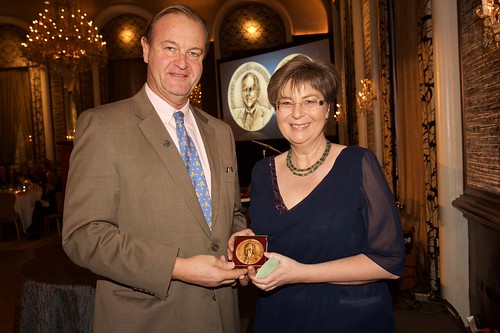
Ursula Kampmann with Mark Anderson and her
Burnett Anderson Memorial Award medal
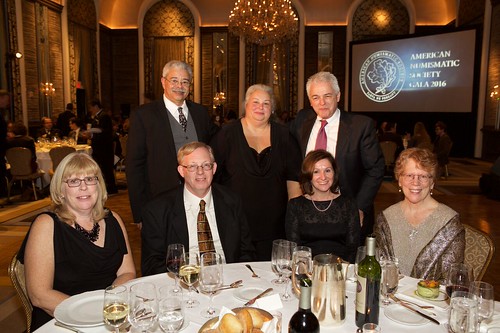
Seated: Dee and Wayne Homren, CJ Musante, Anne Bentley
Standing: Bob and Elizabeth Williams, Neil Musante
To read the earlier E-Sylum article, see:
WAYNE'S NUMISMATIC DIARY: JANUARY 10, 2016
(www.coinbooks.org/esylum_v19n02a24.html)
COINWEEK INTERVIEW WITH HARLAN J. BERK
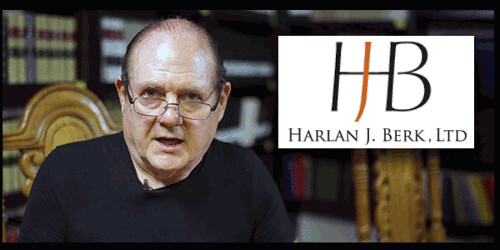
Harlan J. Berk founded the company that bears his name in 1964, but like so many other numismatists, he actually got his start as a kid when someone (in Berk’s case, his mother) gave him those first fascinating coins. And now, after 52 years plus as a professional and a coin dealer–specializing in ancient and United States coins–Berk is one of the most respected names in the industry.
As such, CoinWeek sat down with the noted Chicago dealer and author to talk about his love for ancient coins and to find out what this area of numismatics offers today’s collector. We also asked him about some of the recent controversies in the field of antiquities and what impact they have on the business of coin collecting.
CoinWeek: Harlan, you wrote the book 100 Greatest Ancient Coins (Whitman, 2008). In your opinion, what makes for a great ancient coin?
Harlan J. Berk: There are several factors. First is art – How good is the art on the coin? Next is historical importance. That’s a factor that plays out for the rare coins. What makes a common coin important? Like an Alexander the Great tetradrachm or stater? These coins are great because, at their time, they were so important that they became a world currency.
CW: Even common coins can be great?
HJB: Of course.
CW: That reminds me of an account of the World’s Columbian Exposition, which, of course, took place in Chicago. The [United States] Mint brought a selection of coins from the Mint Cabinet. The two that impressed exhibition goers the most were the 1804 dollar – a great American rarity – and the widow’s mite, a common coin.
HJB: Well, the 1804 dollar was important from the time [it was] minted in 1840 and 1861. The widow’s mite… that’s important because of Christianity. It was an important coin in the bible. As a coin, though, it’s incredibly ugly and worthless.
CW: What other factors create new collectors?
HJB: A lot of people come into our shop because they want to buy an ancient coin for their son or daughter from a certain date or period in history. When I bring out double row boxes of coins, they are shocked. “Well, I can’t pay much,” they say, so I ask “What’s your price range? We have over 5,000 attributed ancient coins in stock”.
Other people that come in are more sophisticated than we are. We know a lot, but we don’t know everything.
CW: What other factors create new collectors?
HJB: A lot of people come into our shop because they want to buy an ancient coin for their son or daughter from a certain date or period in history. When I bring out double row boxes of coins, they are shocked. “Well, I can’t pay much,” they say, so I ask “What’s your price range? We have over 5,000 attributed ancient coins in stock”.
Other people that come in are more sophisticated than we are. We know a lot, but we don’t know everything.
To read the complete article, see:
The Modern
Hobby of Ancient Coins – A CoinWeek Exclusive with Harlan J. Berk
(www.coinweek.com/featured-news/coinweek-exclusive-interview-harlan-j-berk-on-the-modern-hobby-ancient-coins/)
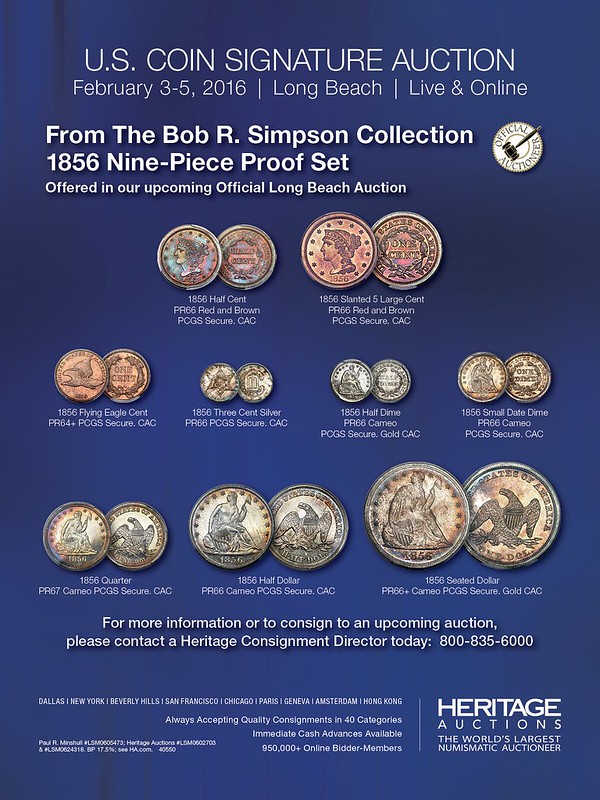
CNG’S TRITON XIX REALIZES OVER $26 MILLION
Classical Numismatic Group of Lancaster, Pennsylvania and London, England held their annual Triton auction in conjunction with the 44th Annual New York International Numismatic Convention (NYINC) on January 5-6, 2016. Triton XIX was the firm’s largest and most successful auction to date with the total prices realized, before the buyer’s fees, bringing $26,259,955 for all four sessions. Triton XIX consisted of two separate catalogs: the first catalog featured 993 lots of ancient Greek, Celtic, Oriental Greek, Central Asian, Roman Provincial, Roman Republican, and Roman Imperial coinage. Additionally, there were featured selections of Byzantine, Early Medieval, Islamic, World, and British Coinage. The pre-sale estimate total for Triton XIX, Part I was $7.2 million, and the total of actual prices realized for Part I was $8,798,055 on the hammer (buyer’s fees not included, which were either 19 or 21%, depending on the method of bidding).
Part II of Triton XIX featured the third part of the Dr. Lawrence A. Adams Collection of Ancient & World Gold Coinage, with a pre-sale estimate total of $5.6 million. The total of prices realized for Part III of the Adams collection was an astounding $17,461,900 on the hammer (again, this total does not include the 19 or 21% buyer’s fee). Part III of the Adams collection consisted of 801 lots of ancient Greek, Celtic, Oriental Greek, Central Asian, Roman Provincial, Roman Republican, and Roman Imperial coinage. Additionally, there were featured selections of Early Medieval & Islamic, World, and British Coinage, as well as Olympic and World medals. Overall, for both parts of Triton XIX, 98.3 of all lots were sold.
Just a few of the many individual highlights from Triton XIX, Part I were:
Ex Gillet, Vicomte de Sartiges, Berlin Königliches Münzkabinett, and Löbbecke
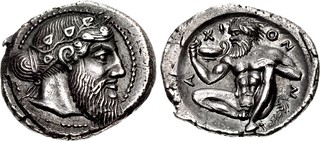
Lot 44–SICILY, Naxos. Circa 461-430 BC. AR Drachm (19mm, 4.32 g, 7h). Bearded head of Dionysos right, wearing tainia decorated with an
ivy branch / Silenos, nude and bearded, squatting half-left, holding kantharos in right hand and resting his left on his knee, tail behind;
N-A-XI-ON around; all within shallow concave circular incuse. Cahn 55.1 (V40/R46) = Gillet 484 = Sartiges 110 = H. Dannenberg, Grundzüge
der Munzkunde (1912), pl. I, 7 = J. Friedländer, “Die Erwerbungen des Koniglichen Miinzkabinets vom 1. Januar 1877 bis 31. März 1878.” in
ZfN 6 (1879), p. 10 and pl. I (this coin); Rizzo pl. XXVIII, 13; SNG Lloyd 1151 = Weber 1467; Basel 385; SNG Lockett 841 = Pozzi 508;
Jameson 674; de Luynes 1063; McClean 2467 (all from the same dies). Superb EF, lovely deep cabinet tone. Among the finest examples of the
type, with a choice pedigree.
Estimated at $150,000; Realized $170,000 on the hammer.
Ex Leu 81 (16 May 2001), lot 89; Charles Gillet Collection (1972), 484; Vicomte de Sartiges Collection, 110; Duplicates from the Berlin Königliches Münzkabinett (J. Hirsch XXVI, 24 May 1910), lot 81 (acquired by the museum circa 1874); Arthur Löbbecke Collection.
An Exceptional Year Five Shekel
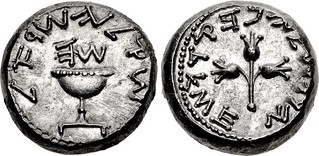
Lot 306–JUDAEA, Jewish War. 66-70 CE. AR Shekel (22mm, 13.68 g, 12h). Jerusalem mint. Dated year 5 ([August] 70 CE). Omer cup; “Y[ear]
5” (date) in Hebrew above, “Shekel of Israel” in Hebrew around / Sprig of three pomegranates; “Jerusalem the holy” in Hebrew around.
Meshorer 215; Kadman 45 (same obv. die as illustration); Hendin 1370 (same obv. die as illustration); Bromberg 389 (same obv. die);
Shoshana I 20221 (same obv. die); Sofaer –; Spaer –. EF, lightly toned. Very rare, and among the finest known, far superior to those in
CoinArchives.
Estimated at $200,000; Realized $300,000 on the hammer.
From the David Hendin Collection, acquired in 1992 via an exchange with a European collector.
The Finest Portrait Brutus Aureus
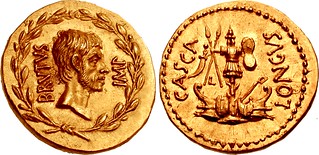
Lot 420–The Republicans. Brutus. Late summer-autumn 42 BC. AV Aureus (19.5mm, 8.01 g, 12h). Military mint traveling with Brutus and
Cassius in western Asia Minor or northern Greece. P. Servilius Casca Longus, moneyer. Bare head of Brutus right, wearing short beard;
BRVTVS behind, IMP before; all within laurel wreath / A combined army and naval trophy, consisting of a cuirass, a crested helmet on the
top, a curved sword and two crossed spears on the left arm, and an oval shield with incurved sides on the right, set on a post made from a
tree trunk; at base, two prows, two shields, and a rudder; on left, between the two spears, the letter L (= Libertas or Lycia); CASCA on
left, LONGVS on right. Crawford 507/1b (same obv. die as illustration); CRI 211; Bahrfeldt 65b; Calicó 56; Sydenham 1297 (same obv. die as
illustration); Kestner –; BMCRR East 62 (same obv. die); CNR 7 = Hess-Leu 1961, lot 14 (same dies); Junia 46 and Servilia 37; Kent & Hirmer
99 (same obv. die). EF, peripheral marks in field on obverse. A superb high relief portrait, boldly struck from fresh dies. Undoubtedly the
finest portrait of Brutus in gold with needle-sharp facial details. Very rare, one of 17 examples known of this issue (of which eight are
in museums).
Estimated at $750,000; Realized $800,000 on the hammer.
The Ides of March
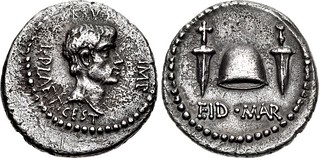
Lot 421–The Republicans. Brutus. Late summer-autumn 42 BC. AR Denarius (18mm, 3.59 g, 12h). Military mint traveling with Brutus and Cassius in western Asia Minor or northern Greece; L. Plaetorius Cestianus, magistrate. Bare head of Brutus right; BRVT above, IMP to right, L • PLAET • CEST around to left / Pileus between two daggers pointing downward; EID • MAR below. Crawford 508/3; Cahn 22 (same dies); CRI 216; Sydenham 1301; RSC 15; RBW –. Good VF, deeply toned, a little off center and minor porosity on obverse. Very rare. The most famous of all Roman coins. Estimated at $100,000; Realized $120,000 on the hammer.
Iconic Rarity of the Umayyad Caliphate
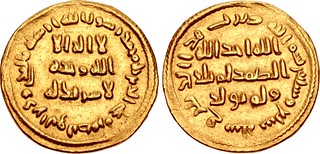
Lot 712–ISLAMIC, Umayyad Caliphate. temp. 'Abd al-Malik ibn Marwan. AH 65-86 / AD 685-705. AV Dinar (20mm, 4.24 g, 6h). Unnamed
(Dimashq [Damascus]?) mint. Dated AH 77 (AD 696/7). First portion of the kalimat at-tawḥīd: lā ilāha
illā-llāhu waḥdahu lā sharīka lahu (there is no god except Allah, and one [is] he; (there is) no partner to him)
in three lines; in outer margin, the “Umayyad Second Symbol” (Sura 9 [al-tauba]:33): muḥammadur rasūlu-llāh arsalahu
bi-’lhudā wa dīn al-haqq lī-yuzhirahu ’ala al-dīn kollihi walau kariha al-mushrikūn (Muhammad id the messenger of
Allah; him He sent with guidance and true faith to make it prevail over all other faiths even though the polytheists may hate it) / The
“Umayyad Symbol” (Sura 112 [al-ikhlas]) Āllah ahad Āllah āl-samad lam yalīd wa lam yalūd (Allah [is] One; Allah
[is] the Eternal, the Absolute; not begetting and not begotten) in three lines; in outer margin, b-ismi-llāh zarb hazā
āl-dinār fī sanat seb’ wa seb’īn (in the name of Allah struck this dinar in the year seven and seventy (after the
Hijra)). AGC I 41; SICA 2, 1 (same dies); Walker, Arab-Byzantine, 186; Album 125; W 155. EF, minor edge marks. Very rare.
Estimated at $200,000; Realized $225,000 on the hammer.
Magnificent Offa Penny
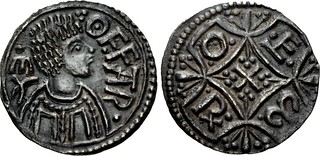
Lot 869–ANGLO-SAXON, Kings of Mercia. Offa. 757-796. AR Penny (17mm, 1.29 g, 11h). Light coinage, portrait type. Canterbury mint;
(Ealred, moneyer). Struck circa 779-792/3. ΘFFA RЄX, bareheaded bust right / O F (Rx) (Mercian m) on the limbs of a Celtic cross
with fleurs in angles, lozenge center containing saltire; trefoil-headed scepter in each angle. Chick 94a = Chick, Towards, pl. I, 10 = EMC
2001.1158 (this coin); SCBI –; BMC 30 (same rev. die); North 290; SCBC 905 (this coin illustrated). Choice EF, deeply toned. A magnificent
coin, with an unusually sculptural portrait in high relief. Extremely rare in this condition.
Estimated at $20,000; Realized $40,000 on the hammer.
From the Dr. Andrew Wayne Collection, purchased from Mark Rasmussen, 19 August 2010. Ex Derek Chick Collection. Found near Donnington Church, Chichester, West Sussex, September 1988.
The Standard Catalogue of British Coins (50th edition) plate coin.
And a few of the individual highlights from Part III of the Adams Collection were:
Largest Carthage Electrum Denomination
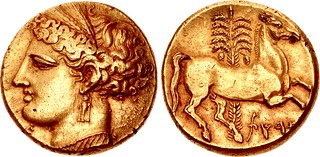
Lot 2030–CARTHAGE, First Punic War. Circa 264-241 BC. EL Tristater (29.5mm, 22.40 g, 12h). Uncertain mint in Sicily. Head of Tanit left,
wearing wreath of grain ears, triple-pendant earring, and necklace / Horse prancing right; palm tree in background, B’RŠT (in Neo-Punic)
below. Jenkins & Lewis Group VIII, 327 = Jenkins, Punic, Part IV, p. 54, dies O1/R6; CNP 211; SNG Lockett 1063 (same dies); Basel 568 (same
obv. die); Gulbenkian 377 = Walcher de Molthein 456 (same dies); Jameson 922 (same dies); Sartiges 387 (same rev. die). Near EF, toned, a
little die wear on obverse. Very rare, only sixteen known to Jenkins, ten of which are in museums, none in CoinArchives.
Estimated at $50,000; Realized $250,000 on the hammer.
From the collection of Dr. Lawrence A. Adams. Ex Distinguished American Collection (Leu 52, 15 May 1991), lot 37; Sternberg XX (20 April 1988), lot 508.
Gold Taken from Athena Parthenos
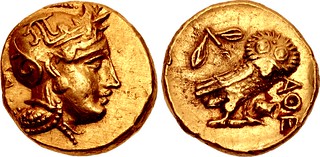
Lot 2041–ATTICA, Athens. 295 BC. AV Stater (17mm, 8.60 g, 9h). Head of Athena right, with profile eye, wearing crested Attic helmet
decorated with a “pi-style” palmette, disk earring, and pearl necklace / Owl standing right, head facing; olive sprig and crescent to left,
AΘE and Eleusis-ring to right. J. Kroll, “The Reminting of Athenian Silver Coinage, 353 B.C.” in Hesperia 80 (2011), fig, 12, b;
Svoronos, Monnaies, pl. 21, 17 = Jameson 1193 (same rev. die); HGC 4, 1577; SNG Copenhagen 83; BMC 129–31; Boston MFA 1099; Gillet 946;
Gulbenkian 925 = Weber 3499. Near EF, a few scattered marks, minor deposits on reverse. Very rare.
Estimated at $100,000; Realized $265,000 on the hammer.
From the collection of Dr. Lawrence A. Adams. Ex Numismatic Fine Arts XXX (8 December 1992), lot 71; Distinguished American Collection (Leu 52, 15 May 1991), lot 74; Christie’s New York (22 September 1986), lot 8.
Unique Stater of Pharnakes I
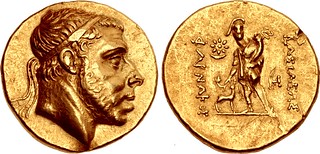
Lot 2053–KINGS of PONTOS. Pharnakes I. Circa 200-169 BC. AV Stater (19.5mm, 8.47 g, 12h). Amisos mint. Diademed head right /
BAΣIΛEΩΣ ΦAPNAKOY, male figure, wearing flat headdress, holding cornucopia in right hand, vine branch in left,
from which a deer, standing right, feeds, on his left; MH monogram to inner right. Callataÿ, First, dies O1/R1, and fig. 15 = Göbl, Antike
877A (this coin); HGC 7, 322 (this coin illustrated); Alram 26 (this coin referenced and illustrated). Good VF, light scuff and edge mark
on reverse. Unique.
Estimated at $50,000; Realized $225,000 on the hammer.
From the collection of Dr. Lawrence A. Adams. Ex Margaretha Ley Collection (Lanz 70, 21 November 1994), lot 81; Tkalec & Rauch (25 April 1989), lot 105; Leu 22 (8 May 1979), lot 116; Kastner 4 (27 November 1973), lot 52.
Portrait Gold Issue for Charlemagne
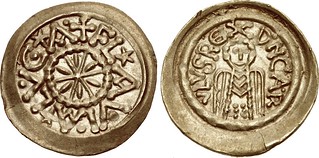
Lot 2207–CAROLINGIANS. Charlemagne (Charles the Great). As Charles I, King of the Franks, 768-814. AV Tremissis (17mm, 0.98 g, 11h).
Lucca mint. + FL (star) A VI • A (star) LVC (star) A •, D • N CA•R VLVS RЄX, facing half-length bust. Bernareggi –; Bernareggi,
Tremissi –; Bernareggi, Moneta, –; Depeyrot 515B = CNI IX 1 = Gariel 172 = Kluge 199; BMC Vandals –; Arslan –; MEC 1, –; E&S p. 213. EF,
lightly toned. Extremely rare, second example of this variety known.
Estimated at $75,000; Realized $180,000 on the hammer.
From the collection of Dr. Lawrence A. Adams. Ex Classical Numismatic Group Inventory 735868 (August 2003).
Ex Brand Collection

Lot 2258–BOHEMIA, Holy Roman Empire. České království (Kingdom of Bohemia). Ferdinand III. 1627-1657. AV 50 Dukát (75mm, 172.4 g,
12h). Commemorating his Coronation as King of Hungary & Bohemia. Praha (Prague) mint. Dated 1629. FERDINANDVS · III · D : G : HVNG :
BOHEMIÆ · REX :, armored and draped bust right, wearing elaborate ruff and Collar of the Order of the Golden Fleece; all within wreath; 50
(denomination) engraved in medallion at bottom of wreath / AVSTRIÆE ARDCHIDVX, crowned garnished coat-of-arms with dragon supporters above
Collar of the Order of the Golden Fleece; 16 29 below; all within wreath. Herinek 82; Dietiker –; KM –; Friedberg 44. VF, scattered marks
and scratched, edge knocks, double struck.
Estimated at $100,000; Realized $250,000 on the hammer.
From the collection of Dr. Lawrence A. Adams. Ex Virgil M. Brand Collection (Part 8, Sotheby’s, 24 January 1985), lot 304 (purchased from J. Hirsch 27 November 1919).
Portrait Mohur of Jahangir
Ex Garrett Collection
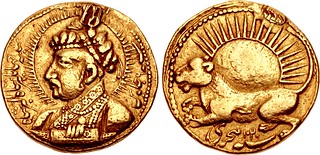
Lot 2396–INDIA, Mughal Empire. Nur al-Din Muhammad Jahangir. AH 1014-1037 / AD 1605-1627. AV Mohur (23mm, 10.99 g, 11h). Portrait type,
Class A. Dually dated AH 1020 and RY 6 (16 March – 14/23 October AD 1611). shabih-e Jahangir Shah Akbar Shah (likeness of Jahangir Shah
[son of] Akbar Shah) in Persian to left, sanat 6 jalus (regnal year 6) in Persian to right, bust left; left hand resting hand on throne /
Lion recumbent left; radiate sun behind; sanat 1020 hijri (year 1020 of the Hijra) in Persian to right. BM 312; Wright 587; Hull 1437; KM
179.1; Friedberg 758. VF, remains of suspension loop mounting. Very rare contemporary issue presented to preferred courtiers.
Estimated at $20,000; Realized $400,000 on the hammer.
From the collection of Dr. Lawrence A. Adams. Ex John Work Garrett Collection (Part I, Leu/Numismatic Fine Arts, 16 May 1984), lot 476 (purchased from Max Schulman, 11 November 1928); Hennessy Collection.
Zodiac Mohur
Constellation of Varak/Mesha or Aries the Ram
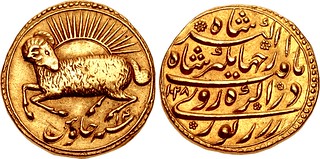
Lot 2399–INDIA, Mughal Empire. Nur al-Din Muhammad Jahangir. AH 1014-1037 / AD 1605-1627. AV Mohur (22mm, 10.91 g, 4h). Zodiac Type,
Class A. Agra mint. Dually dated AH 1028 and RY 14 (19 December AD 1618 – 14/23 October AD 1619). Constellation of Varak/Mesha (Aries the
Ram): ram, head right, recumbent left; radiate sun behind; sanat 14 jalus (regnal year 14) in Persian below / zar zewar dar Agra ruye yaft
az Jahangir Shah Akbar Shah (Received ornament on gold at Agra from Jahangir Shah [son of] Akbar Shah) in Persian verse; AH date to left.
BM 322; Wright 570; Hull 1379; KM 180.1; Friedberg 762. Good VF, lightly toned, minor spot of deposit on obverse.
Estimated at $10,000; Realized $275,000 on the hammer.
From the collection of Dr. Lawrence A. Adams. Ex Schweizerischer Bankverein 30 (15 September 1992), lot 2784; John Work Garrett Collection (Part I, Leu/Numismatic Fine Arts, 16 May 1984), lot 477 (purchased from Max Schulman, 8 November 1927); Prince Philipp von Sachsen-Coburg-Gotha Collection (not in the Hamburger sale).
Ex Brand Collection
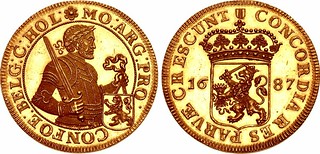
Lot 2557–LOW COUNTRIES, Republiek der Zeven Verenigde Nederlanden (Dutch Republic). Holland. 1581-1795. AV ‘Rijksdaalder’ (40mm, 34.63
g, 12h). Dordrecht mint. Dated 1687. Armored half-length bust right, holding sword over shoulder and coat-of-arms on ribbon / Crowned
coat-of-arms. P&W Ho 40.3; CNM 2.28.77; KM –; Friedberg –. Choice EF, frosted proof-like strike, minor edge ding. Off-metal strike in gold.
Estimated at $10,000; Realized $150,000 on the hammer.
From the collection of Dr. Lawrence A. Adams. Ex Virgil M. Brand Collection (Part 6, Sotheby's, 17 May 1984), lot 278.
Gold Irish ‘Gunmoney’
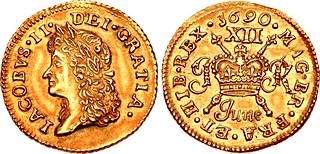
Lot 2752–IRELAND. James II. 1685-1691. Proof AV ‘Shilling’ (23mm, 5.87 g, 12h). ‘Gunmoney’ coinage. Dublin or Limerick mint. Dated June 1690. Laureate head left / Crown over two scepters crossed in saltire; J R in script across field, XII above, June in script below. D&F 444; SCBC 6582g. Near EF, toned, scratches. Extremely rare. Estimated at $10,000; Realized $30,000 on the hammer.
From the collection of Dr. Lawrence A. Adams, purchased from M. Louis Teller, November 1985.
CNG is currently accepting consignments for its next mail bid auction, CNG 102, scheduled for May 18, 2016. The consignment deadline is Friday, January 29, 2016. For further details and any additional information, please contact CNG, Inc. at:
Classical Numismatic Group, Inc.
P.O. Box 479
Lancaster, PA 17608-0479
Telephone: (717) 390-9194
Fax: (717) 390-9978
Email: cng@cngcoins.com
To read the earlier E-Sylum article, see:
CNG TRITON XIX SALE HIGHLIGHTS (www.coinbooks.org/esylum_v18n49a25.html)

DERBYSHIRE EDWARD III QUARTER NOBLE TO BE SOLD
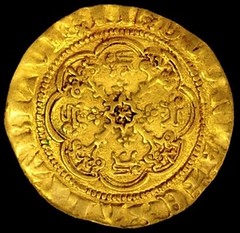 A REMARKABLE gold coin, which had laid in a Derbyshire field for centuries, will be sold at our auction room in March.
A REMARKABLE gold coin, which had laid in a Derbyshire field for centuries, will be sold at our auction room in March.
It is such a wonderful find for a metal detectorist to make. Derbyshire is awash with history and the land is also rich in objects which have been lost since Anglo Saxon times.
The gold coin, which measures approximately 2cm across its diameter, was uncovered in the north of the county late last year.
It was brought into a Hansons coin and medal antiques valuation day last week.
Head of our coin department Don Collins said: "A Quarter Noble as a denomination was minted when Edward III was King of England from 1327-77. It was the first English gold coin produced in quantity."
It is remarkable to think this coin was lost by perhaps a local person some 650 years ago. If only the coin could talk.
Mr Collins added: "We can be quite precise in dating the coin since we know the design of the coin is from Edward III's treaty period of 1361-69. With a shield to one side and foliage cross to the other, the coin is inscribed in Latin 'Edward by the grace of God King of England Lord of Ireland and Aquitaine'."
Weighing only 1.9 grams, it is in extremely good condition, with fine detail evident on both sides. Unlike bronze and base metals, gold can maintain untarnished.
Life in the 1360s when this coin was minted was very tough. The period witnessed the Black Death and Great Famine, which killed around half of England's population.
To read the complete article, see:
Rare coin
unearthed in Derbyshire set to go under the hammer
(www.derbytelegraph.co.uk/Bygones-Rare-coin-unearthed-Derbyshire-set-hammer/story-28586388-detail/story.html#3)
THE BOOK BAZARRE
GORNY & MOSCH SPRING 2016 AUCTIONS 236-238
Spring auction at Gorny & Mosch: Numismatic masterpieces from antiquity, the middle ages and modern times.
From March 7th – 9th, 2016 Gorny & Mosch will conduct its traditional spring auction. Three sessions will offer numismatic masterpieces dating back as far as 2,500 years: From antiquity to the medieval period and modern times.
As every year, Gorny & Mosch will conduct its spring auction following the Numismata. The auction is comprised of three catalogues. Premium-quality ancient coins will go over the auction block on Monday. Then, in the late afternoon of Monday auction 237 will start, including ancient coins and lots, which will be continued the following day. Wednesday will be devoted to medieval and modern coins.
Auction 235 – Premium-quality ancient coins
Auction 235 will feature ancient coins, which distinguish themselves through their style, condition, rarity and provenance; or everything
combined. 5 Celtic coins, including a gold stater of the Bellovaci (2, EF, 3,200 euros), which can be compared to works of Picasso because
of its stylistic simplicity, will be followed by Greek coins. Among them, the connoisseur will find many spectacular rarities.
Greek coins
As an example we can name a Sicilian tetradrachm from the city of Katane, which presents one of the finest specimens of an emission so
popular due to its fine style. Since the coin is in such extraordinary condition, Apollon’s elegant head, indicating a light smile, can be
studied in full details (35, EF, 25,000 euros). Another example is an extremely fine Syracuse tetradrachm, whose dies were cut by Euth… and
Phrygillos. Back then, this piece was very innovative: on the reverse, the wheat wreath identifies the female goddess, normally Arethusa,
with Kore or Demeter. Phrygillos, responsible for this design, was one of the most appreciated artists of his times and he worked for
Thurion and Terina (65, extremely fine, 18,000 euros). But this is not the only rarity from Sicily: Let’s take, for example, a dekadrachm
of Euainetos (69, EF, 15,000 euros), a unique didrachm in gold, which was produced after 400, but reverted to the long obsolete quadratum
incusum on its reverse (68, EF, 1,500 euros), and last but not least, a bronze of Timoleon in perfect condition displaying the finest green
patina (76, VF-EF, 3,500 euros).
A very special specimen is an extremely rare and perfectly preserved didrachm from Thermae Himerenses, where the displaced people of Himeras settled down after their city was destroyed in 408. Heracles is shown on the reverse, who, according to local legends, had visited the hot springs of this locality (93, EF, 45,000 euros).
A small series of unusually well preserved Cretan strikings will delight the connoisseur. As will a Gortyn drachm of extraordinary quality displaying Europe riding the bull (208, EF, 2,500 euros) and a stater from Phaistos, showing Herakles fighting the hydra on the obverse and the Cretan bull on the reverse (210, VF, 4,000 euros).
Mintings of the Near East feature an Arabic tetradrachm of Abiel, daughter of Labas, of the Alexander type (295, EF, 10,000 euros). Furthermore, there are a few pieces in extraordinary condition stemming from the kingdom of Elymais and Parthia of which we’d like to mention the following: a tetradrachm portraying the Parthian ruler Baydad of the 3rd century B.C. (297C, VF-EF, 4,000 euros). And finally, a series of Sasanian coins including many rarities.
Roman Republic
The collector of coins of the Roman Republic should pay attention now: From “ramo secco” bars to aes grave and denarii and aurei, there are
many pieces on offer, which will make every collector rejoice. Especially the high-quality preservation of the coins, favorably appraised,
will, no doubt, attract many interested bidders.
Roman Empire
Also coins of the Roman Empire will be plentiful. There are gold, silver and bronze coins, every collector, who strives for quality, will
be satisfied. Let’s name a few examples:
If we are talking about gold, it is certainly the aurei of the soldier emperors, which steal the show. There is Philip II as Caesar (481, EF, 22,000 euros), Trebonianus Gallus (484, FDC, 30,000 euros) or Volusianus (486, EF, 22,000 euros). All of those strikings are extremely rare, specifically considering their condition.
Among the silver pieces, one specimen in particular shows the potential of the denarii. The Caracalla denarius, featuring a temple with the statue of Roma on its reverse, in front of which, on each side, six figures are placed, is unique and until now only known as an aureus (470, EF, 3,500 euros).
A bit more frequent, but due to their condition noteworthy, are the bronzes offered at the auction. A good example is a sestertius of Nero. Its reverse displays the distribution of the congiarium (427, EF, 17,500 euros). But there are also quite a few rarities: for example a sestertius of Britannicus (421, EF, 57,500 euros) or a medallion of Constantius Chlorus prior to his appointment as Augustus (498, EF, 8,000 euros).
Last but not least, Byzantine coins and gold coins of the great migration period will end this session.
Auction 237 – Ancient coins and lots
Any bidder who didn’t get lucky at the first auction should definitely take part in auction 237. Many interesting rarities, especially in
the area of Greek fractions and bronzes will go over the auction block.
From the collection of Sasanian coins, out of which the top pieces were sold at auction 236, a bit less attractive specimens will be sold in this auction. For a real collector though it shouldn’t matter that the condition of an extremely rare bronze coin of Vahram I from Balkh is only rated very fine (1532, 250 euros).
Gold, silver and bronze – and lead in the case of Byzantine seals – auction 237 contains many Roman and Byzantine strikings, which are not seen every day. Also please take a good look at the lots. Next to more Sasanian coins, numerous other pieces, sensibly put together and favorably priced, will be on offer. After all, Gorny & Mosch is known for its famous lots!
The same goes for the book lots, which, this time, consist of literature concerning the Near and Far East, some of the books are definitively rare and hard to detect on the market.
Auction 238 – Middle Ages / Kolb Medal Collection / Islam Collection
On Wednesday, March 9th, 2016, coins of medieval and modern periods will be auctioned off. The session starts with a magnificent
Merovingian tremissis (3001, VF-EF, 2,000 euros).
German Coins
The auction will continue with numerous rarities of pre-1871 German strikings, including many rare gold coins in excellent conditions. For
example an 1819 Baden-Durlach 10 gulden piece, of which only 4,332 pieces were minted (3014, EF-FDC, 7,500 euros). It is extremely well
persevered, just as the 1741 double ducat of Charles William Frederick of Brandenburg (3031, EF-FDC, 7,500 euros). Also very attractive is
a 1634 ducat of Regensburg, showing a detailed view of the city with its stone bridge on the reverse (3072, EF+, 4,000 euros).
But also among the talers many rare pieces in outstanding condition can be found. For example a 1694 Hamburg double taler featuring the gorgeous city seal displayed in a baroque cartouche (3044, VF-EF, 10,000 euros). But let’s not forget about the regiment taler of the city of Ravensburg, showing on its reverse the steepled city view and the city wall. Only 187 pieces of this rarity were minted (3068, VF-EF, 5,000 euros).
This is followed by a section of post-1871 German coins, all in extraordinary condition. Here are a few examples: Anhalt, 5 marks 1914, FDC, estimated at 500 euros (3103); Bavaria, 5 marks 1874 D, NGC PF 65, Proof, estimated at 4,000 euros (3109A); Prussia, 2 marks 1877 A, Proof, estimated at 1,000 euros (3127C); Weimar Republic, 5 reichsmarks 1930G, NGC PF65, Proof, estimated at 7,500 euros (3202A).
Kolb Collection
If you are interested in medals, make sure to check out auction 238. It contains parts of the Augsburg Kolb Collection. Mainly, medals of
the Renaissance are being offered. The geographical focus lays on the German Empire and Italy. Especially remarkable are the many German
personal medals, commemorating more or lesser known individuals. Merchants, gold smiths, university presidents, professional soldiers and
majors, all of them appear to us on medals. It is especially worth mentioning, that the former collector did not only collect medals, but
also other pieces of art, which served as a substitute for the expensive production of a medal in the 16th and 17th century and which are
nowadays even more rare then their bronze counter pieces. We find a medallion cut in stone, hand-colored plaster-medallions, as well as a
terracotta-medallion. Concerning the history of religion, the figure-rich strikings of the time of the Reformation, when the newly
accentuated old truths of faith were put in the round of the medal, also need to be mentioned.
World Coins
Coins of the Holy Roman Empire of German Nations lead to European strikings. Especially under the headline of Italy there is much to marvel
about. For example a perfect Saluto d’oro from Charles I of Anjou, displaying a charming motif of the Annunciation (3336, almost FDC, 3,500
euros). Considered extremely rare is a denarius from Pope John X in cooperation with Berengar I (3370, VF, 7,000 euros). It witnesses a
time of war. Berengar became Emperor after he had captured his competitor Louis of Lower Burgundy and blinded him. His reign ended with his
own murder, when Rudolf II of Upper Burgundy in Italy invaded. Rudolf’s supporter, Pope John X, was deposed in 928 and murdered in prison.
A series of Venetian ducats will conclude the Italian part of the auction.
The Portuguese coins also offer a specimen, which can only rarely be seen. This Morabitino of Sancho I, in a stylized design, shows the King riding a horse (3405, EF-FDC, 15,000 euros).
The most expensive piece of the auction comes from Russia. It is an extremely rare medal of merit of Paul I, which was awarded to Counts, Khans, as well as to Serbian and Montenegrian Voivodes (war lords) who served the czarist government (3414A, VF+, 100,000 euros). This is probably the only known specimen on the market!
Please also take a look at our medieval and modern coin and medal lots, which are not only interesting but also favorably priced. There is, for example, a convolute of German coins, which represents an entire private collection. The sum of the nominal value amounts to 1,730 euros (3499). The estimate is 2,000 euros.
A collection of Islamic coins is to follow, among which there are many Arab-Sasanian coins from the Sasanian Collection, of which most of the coins were offered in the prior two auctions.
Lastly, there will again be a big part of strikings of the Ottoman Empire for sale, like a very rare 4 kabir ashrafi from Ahmad III (3550, VF-EF, 6,000 euros).
All catalogues may be viewed online at http://www.gmcoinart.de/online-katalog and ordered at Gorny & Mosch, Giessener Münzhandlung, Maximiliansplatz 20, D-80333 Munich, Tel. +49 / (0)89 / 24 22 643-0, Fax +49 / (0)89 / 22 85 513.
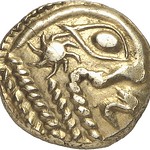

No. 2: BELLOVACI (North Gallia and Gallia Belgica). Stater, ca. 60-25. D&T 271 (this piece). Extremely fine. Estimate: 3,200 euros
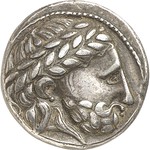
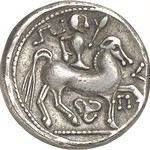
No. 24: AKRAGAS (Sicily). Tetradrachm, ca. 420. From MMAG Auction 62 (1982), 34). Very rare. Good very fine. Estimate: 12,000 euros
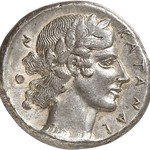

No. 35: KATANE (Sicily). Tetradrachm, ca. 450-445. HGC 566 (this piece). Very rare. Most likely one of the best specimen of this type. Extremely fine. Estimate: 25,000 euros
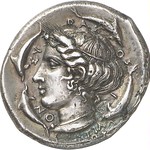
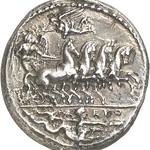
No. 65: SYRACUSE (Sicily). Tetradrachm, ca. 413-409. Signed piece of Euth… and Phrygillos. From Auction NAC 2 (1990), 101. Extremely fine. Estimate: 18,000 euros
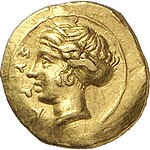
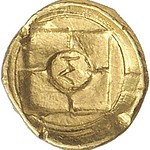
No. 68: SYRACUSE (Sicily). Gold didrachm, ca. 405-400. Unique. From Sternberg Auction 19 (1987), 67. Extremely fine. Estimate: 1,500 euros
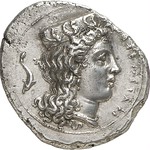
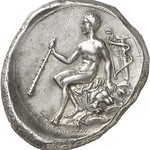
No. 93: THERMAE HIMERENSES (Sicily). Didrachm, 4th century B.C. Very rare. Extremely fine. Estimate: 45,000 euros
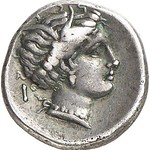
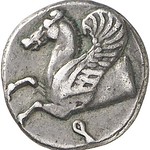
No. 202: ELIS (Peloponnes). Stater, ca. 450-440. Very rare. Extremely fine. Estimate: 15,000 euros
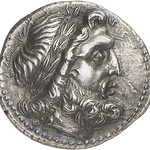
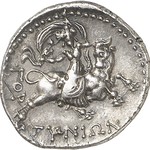
No. 208: GORTYN (Crete). Drachm, 3rd century B.C. From Hirsch Auction 173 (1992), 281. Rare. Extremely fine. Estimate: 2,500 euros
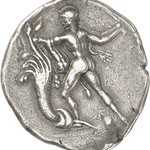
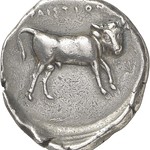
No. 210: PHAISTOS (Crete). Stater, 4th century B.C. From Künker Auction 94 (2004), 909. Rare. Very fine. Estimate: 4,000 euros
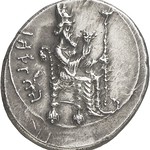
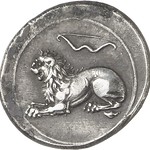
No. 275: TARSOS (Cilicia). Mazaios, 361-334. Stater. Extremely rare. Extremely fine. Estimate: 20,000 euros
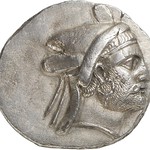
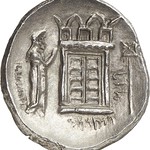
No. 297C: BAYDAD, King of the Parthians 3rd century B. C. Tetradrachm. Rare. Very fine to extremely fine. Estimate: 4,000 euros
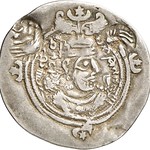
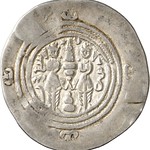
No. 304: AZARMINDUKHT, Queen of the Sasanian Empire 632. Drachm, Ctesiphon. Extremely rare. Very fine. Estimate: 6,000 euros
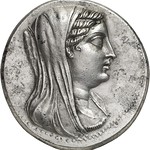

No. 313: PTOLEMAIOS III, king of Egypt 246-221. Dodecadrachm, Alexandria. Extremely fine. Estimate: 20,000 euros
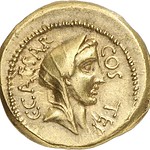
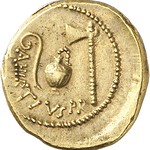
No. 374: C. IULIUS CAESAR, + 44. Aureus, 46. Almost extremely fine. Estimate: 5,000 euros
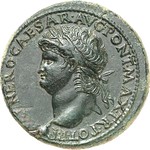
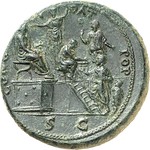
No. 427: NERO, 54-68. Sestertius, 66, Lugdunum. From NAC Auction 52 (2009), 354. Extremely fine. Estimate: 17,500 euros
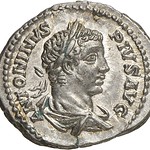

No. 470: CARACALLA, 197-217. Denarius, 206, Rome. Unique. From Tkalec Auction (1998), 217. Extremely rare. Extremely fine. Estimate: 3,500 euros
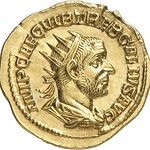

No. 484: TREBONIANUS GALLUS, 251-253. Aureus, Rome. Extremely rare. FDC. Estimate: 30,000 euros
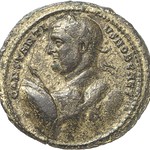
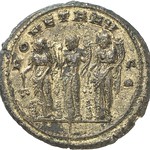
No. 498: CONSTANTIUS I CHLORUS Caesar, 293-305. Medallion, Rome. Unpublished, unique. Gold plating mainly intact. Extremely fine. Estimate: 8,000 euros
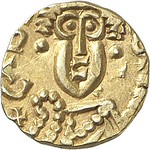
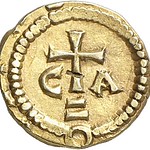
No. 3001: MEROVINGIANS. Austadius, 640-680. Tremissis, no year, Cabilonnum (=Chalons-sur-Saone). Extremely rare. Very fine to extremely fine. Estimate: 2,000 euros
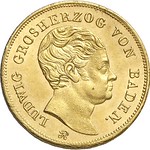
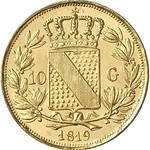
No. 3014: BADEN-DURLACH. Louis, 1818-1830. 10 guldens 1819. 4,332 pieces minted. Extremely fine to FDC. Estimate: 7,500 euros
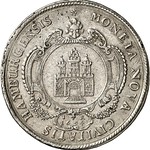
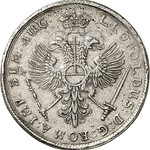
No. 3044: HAMBURG. Double taler 1694. Very rare. Very fine to extremely fine. Estimate: 10,000 euros
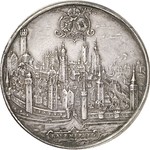
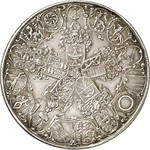
No. 3068: RAVENSBURG. Wide presentation taler 1624, Augsburg. 187 pieces minted. Very fine to extremely fine. Estimate: 5,000 euros
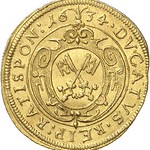
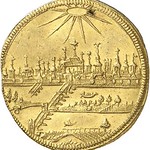
No. 3072: REGENSBURG. Ducat 1634. Very rare. Good extremely fine. Estimate: 4,000 euros
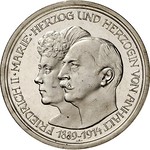
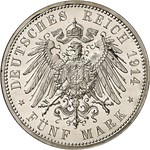
No. 3103: GERMAN EMPIRE. Anhalt. Frederick II, 1904-1918. 5 marks 1914 Silver Wedding Anniversary. J. 25. FDC. Estimate: 500 euros
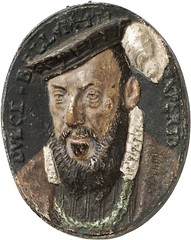
No. 3248: KOLB COLLECTION / MEDALS. Balduin Drentwett (Augsburg). Uniface hand colored plaster-medallion 1577 on the death of Sebastian Schärtlin of Burtenbach, Landsknecht and colonel. Extremely fine. Estimate: 200 euros
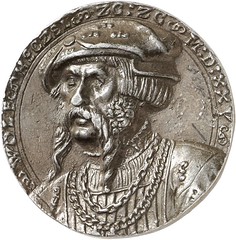
No. 3271: KOLB COLLECTION / MEDALS. Unknown mint master (Nuremberg). Uniface hand colored cast medal in lead 1525 on the great merchant Knight Wolf Ketzel of Nuremberg. Old cast. Very fine to extremely fine. Estimate: 150 euros
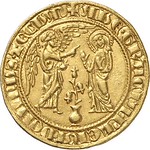
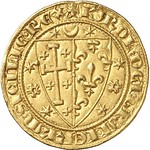
No. 3366: ITALY / NAPLES and SICILY. Charles I of Anjou, 1266-1285. Saluto d’oro, no year, Naples. Very rare. Almost FDC. Estimate: 3,500 euros

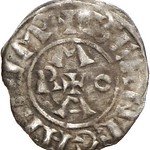
No. 3370: ITALY / VATICAN. John X with Berengar I. Denarius, no year, Rome. Extremely rare. Very fine. Estimate: 7,000 euros
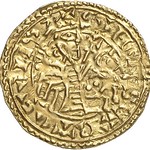
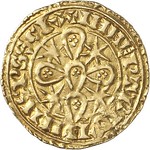
No. 3405: PORTUGAL. Sancho I, 1185-1211. Morabitino (180 dinheros) no year. Extremely rare. Extremely fine to FDC. Estimate: 15,000 euros
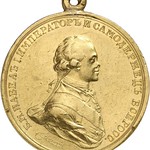

No. 3414A: RUSSIA. Paul I, 1769-1801. Golden Award medal, no year, signed by Leberecht. Extremely rare. Only known specimen on the market. Very fine. Estimate: 100,000 euros
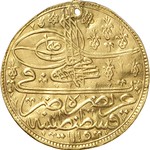

No. 3550: OTTOMAN EMPIRE. Ahmad III, 1703-1730. 4 Kabir ashrafi. Extremely rare. Very fine to extremely fine. Estimate: 6,000 euros
To visit the Gorny & Mosch web site, see:
https://www.gmcoinart.de/

SELECTIONS FROM THE STACKS-BOWERS FEBRUARY 2016 RARITIES SALE
Lot 27: Haiti Bernard Kock 20 Dollars Note

Exceedingly Rare and Enigmatic Bernard Kock 20 Dollars Note From an American Government-Supported Freed Slave Settlement Series Island of A’Vache, Port St. Minna, Haiti, West Indies. Bernard Kock, Lessee of the Island. Jan. 1, 1863. 20 Haitian Dollars/Vignt Gourdes. PCGS Choice About New 58 Apparent. Lithographic Proof.
(Unlisted in the Standard Catalog of World Paper Money). An exceedingly rare and historic American possession rarity with an amazing background that is virtually unknown to United States collectors. Prepared by Arthur, Gregory & Co., Engr. New-York as a lithographic proof on thick paper, a deeply inked impression. Bi-lingual, French and English texts flank top center vignette of African-American field hand picking cotton bisecting issuer BERNARD KOCK. At base, emblem and scroll REPUBLIQUE DE HAITI. Engraved signature of Bernard Kock as superintendent.
The freed slave settlement of Island A’Vache or Cow Island, off the coast of Haiti, is a footnote story in American history that might fill a small a book. It is a key chapter in several re-colonization movements related to the American Abolitionist movement because it happened during the Civil War, on the cusp of the Emancipation Proclamation. Briefly, Mr. Kock, with good intentions, formed his company to settle freed blacks to work on the cotton plantations (the cotton grown there was of high quality, coveted by English manufacturers who were short supplied during the Union blockade of Confederate ports) with those workers eventually being able to become Haitian citizens and landholders.
This plan had the support of investors, as well as the United States and Haiti governments. However, during the emigration and settlement, disorganization and turmoil ensued including a lack of provisions, and eventually rebellion broke out among workers. This chaos placed the State Department and even President Lincoln, who had recently signed his Emancipation Proclamation, in an unfavorable light. The United States did send support in December 1863 and repatriated settlers. The notes themselves were only used at the company store and we record only three examples, all different denominations, offered publicly.
To read the complete lot description, see:
Island of A’Vache, Port St.
Minna, Haiti, West Indies. Bernard Kock, Lessee of the Island. (www.stacksbowers.com/BrowseAuctions/LotDetail/tabid/
227/Lot/27/AuctionID/6134/Default.aspx)
Lot 62: Member Badge of the Tammany Society or Columbian Order.
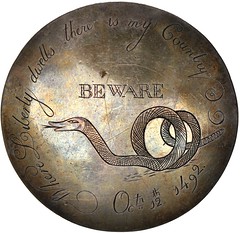
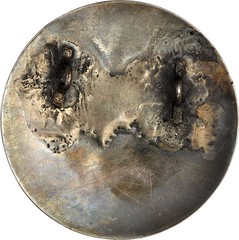
(Circa 1790-1820) Member Badge of the Tammany Society or Columbian Order. Silver, engraved. 67.8 mm. 41.2 grams. Choice Extremely Fine or better.
Carefully engraved and beautifully toned in golden gray with variegated highlights, this is among the most attractive examples of this historic early American badge. The obverse is neatly hand-engraved, showing some light hairlines and a few minor and well-aged scratches. A scrape is seen above the letters OU of COUNTRY. The body of the badge is convex, as made and like most seen, with the unengraved reverse showing heavy solder anchoring two bent silver loops. A ribbon would have been passed through these loops to allow for display on the owner's lapel. The quality of the engraving and the overall aesthetic appeal are excellent.
Founded as a fraternal organization in the wake of the American Revolution, theTammany Society idolized two figures. One was the Lenni-Lenape chief Tamenend, who was described by William Penn in the language of the noble savage. Recounting Tamenend's virtues in 1817, the Native American missionary John Heckewelder wrote, "In the Revolutionary war, his enthusiastic admirers dubbed him a saint, and he was established under the name of St. Tammany, the Patron Saint of America." The other character idolized by the Tammany Society was Christopher Columbus, "the founder of America," giving the organization a distinctly American, even nativist, outlook. As the fraternity got its footing in the 1790s, its membership developed a certain level of socio-economic and political homogeneity: middle class, anti-Federalist, largely composed of urban veterans. It occupied the opposite end of the political continuum from the pro-Federalist Washington Benevolent Society, which was strongest in New York, though chapters existed in most American cities. The Tammany Society's opposition to the Society of the Cincinnati was socio-economic as well as political, populist in voice and fearful of the aristocratic pretensions of the Cincinnati, a group composed of Revolutionary War officers and their oldest sons. The Tammany Society would eventually become known exclusively for its politics, evolving into the Tammany Hall machine that defined American political cronyism for generations.
All of the members badges feature the same design: a coiled rattlesnake with 13 rattles, the word BEWARE in the field above, the legend WHERE LIBERTY DWELLS, THERE IS MY COUNTRY around the circumference, with OCTOBER 12TH, 1492, the date of Columbus' arrival, below. Several of the known badges are clearly made by the same hands. This example is a near twin to the example in the collection of the New-York Historical Society, while the example offered in our (Stack's) September 2009 Americana Sale appears to have been engraved by the same hand as one of the examples in the Rhode Island Historical Society. None of the badges are marked, though Vicken Yegparian has made a persuasive case for several originating in Rhode Island.
Of the 12 known examples, four have been in Rhode Island institutions for over a century. Others are included in the William Sumner Appleton Collection at the Massachusetts Historical Society and the New-York Historical Society, leaving just six more in private hands. Four have been sold in major auctions in the last decade, an unusual convergence: the example in the 2006 Bonham's sale of the lifelong collection of William H. Guthman (sold for $18,720), the aforementioned example in our (Stack's) September 2009 sale (sold for $12,650), the bent example that first appeared in our (Stack's) May 2008 Minot Collection Sale (at $10,350), and this one.
The badges of the Tammany Society or Columbian Order are little known, though they have been included in numismatic cabinets dating back to the Civil War.
To read the complete lot description, see:
(Circa 1790-1820) Member Badge
of the Tammany Society or Columbian Order. Silver, engraved. (www.stacksbowers.com/BrowseAuctions/LotDetail/tabid/
227/AuctionID/6134/Lot/62/Default.aspx)
Lot 70: U.S. Mint Retirement Medal
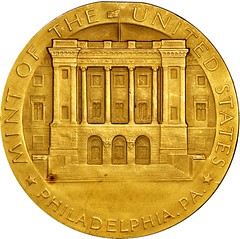
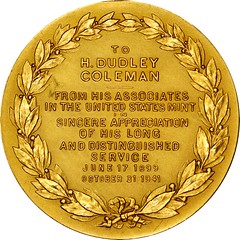
"1899-1941" U.S. Mint Retirement Medal. Gold. 50.6 mm 91.2 grams. Choice About Uncirculated.
This rare medal is 50.6 mm, 1,407.43 grains, and features a view of the front entrance to the third Philadelphia Mint building (1901-1969). Inscription MINT OF THE UNITED STATES / PHILADELPHIA around, signed A. PIETZ at the bottom. This is the same die used on the 1934 Assay Commission medal. The reverse is a specially prepared die, unsigned, with a laurel wreath surrounding the struck-up legend TO / H. DUDLEY / COLEMAN / FROM HIS ASSOCIATES / IN THE UNITED STATES MINT / IN / SINCERE APPRECIATION / OF HIS LONG / AND DISTINGUISHED / SERVICE / JUNE 17 1899 / OCTOBER 21 1941. Matte gold finish in choice About Uncirculated condition with a noticeable edge bump at 12 o'clock.
Housed in a burgundy leather and cream velour presentation case. Once offered as being awarded to Hamilton Dudley Coleman, a New Orleans businessman and politician, who acted as "melter and refiner" at the New Orleans Mint from 1899 to 1905, was an Assay Commission Member in 1912, and died in 1926. However, the dates on the medal do not completely fit this attribution. Perhaps issued to a family member also employed by the Mint. Regardless, this is truly a one-of-a-kind medal worthy of further research. Adam Pietz is also well remembered as the designer of the 1946 Iowa Centennial commemorative half dollar.
To read the complete lot description, see:
"1899-1941" U.S.
Mint Retirement Medal. Gold. 50.6 mm 91.2 grams. (www.stacksbowers.com/BrowseAuctions/LotDetail/tabid/
227/AuctionID/6134/Lot/70/Default.aspx)
Lot 116: 1877 Liberty Seated Quarter
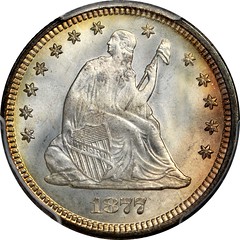
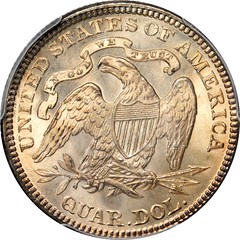
This remarkable Superb Gem needs to be seen to be fully appreciated. Highly lustrous and satin surfaces are adorned with lovely champagne-gold iridescence. The toning is evenly distributed over the reverse, although confined to the periphery on the obverse. Boldly struck throughout and absolutely pristine in virtually all areas. Although the mintage was generous, Larry Briggs offered a word of caution in his 1991 reference The Comprehensive Encyclopedia of United States Liberty Seated Quarters:
"Even though common, not seen as often as one would think. Many likely on hand and melted for new silver dollar [coinage] of 1878."
To read the complete lot description, see:
1877 Liberty Seated
Quarter. (www.stacksbowers.com/BrowseAuctions/LotDetail/tabid/227/
AuctionID/6134/Lot/116/Default.aspx)
Lot 215: 1877 Liberty Half Eagle
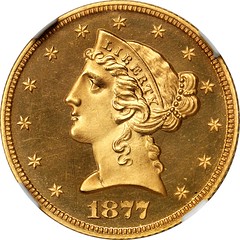
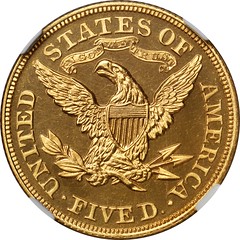
1877 Liberty Half Eagle. Proof-65 Cameo (NGC).
Pale golden surfaces display bold cameo contrast between frosty devices and polished fields. Under closer inspection, light hairlines can be seen when tilted and rotated in a light. One such line on the cheek serves to identify this specimen for provenance purposes, as do a pair of minor carbon flecks near star 13. Boldly struck throughout with only a hint of weakness at the absolute highest points of the design. This is a spectacular Gem Cameo survivor from a minuscule mintage of just 20 pieces. Jeff Garrett and Ron Guth opine that less than half of that number exist today. In the 2008 edition of their reference Encyclopedia of U.S. Gold Coins: 1795-1933, the authors state that "during the course of the last 15 years, there have only been three coins offered at public auction."
To read the complete lot description, see:
1877 Liberty Half Eagle
(www.stacksbowers.com/BrowseAuctions/LotDetail/tabid/227/
AuctionID/6134/Lot/215/Default.aspx)
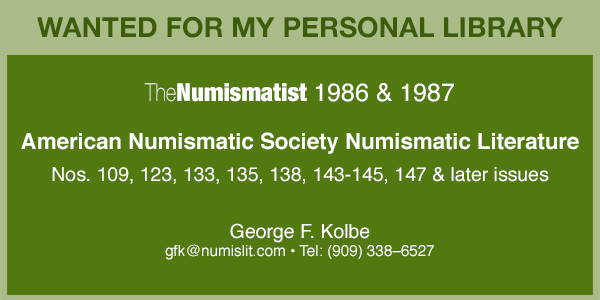
THE SOUTH AFRICA MEDAL
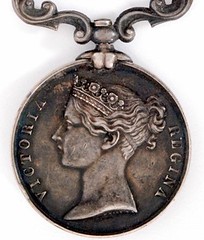 A medal won by a heroic Black Country soldier fighting in a famous battle against Zulu warriors may sell for up to £20,000.
A medal won by a heroic Black Country soldier fighting in a famous battle against Zulu warriors may sell for up to £20,000.
The South Africa Medal was won by Private Joseph Bromwich in the Battle of Rorke’s Drift.
The battle was the inspiration for the 1964 blockbuster movie Zulu, starring Michael Caine and Stanley Baker.
Private Bromwich, then just 22, was one of around 150 troops who defended a mission station for 12 hours against a Zulu force of more than 4,000.
He lies in an unmarked grave in Bilston Cemetery.
The medal is up for auction at Fieldings Auctioneers in Stourbridge on Saturday 6 February.
The seller, a relation of Private Bromwich who wants to remain anonymous, inherited it.
To read the complete article, see:
Medal from battle that
inspired the film 'Zulu' to fetch £20k
(www.itv.com/news/central/2016-01-27/medal-from-battle-that-inspired-the-film-zulu-to-fetch-20k/)
CANADA'S LIBRARY OF PARLIAMENT COIN
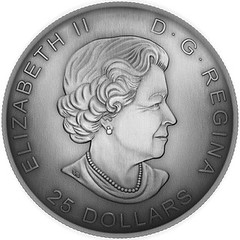
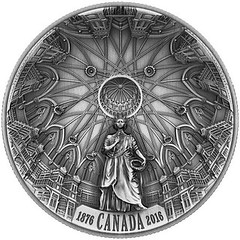
The Royal Canadian Mint has issued its first concave coin in celebration of the 140th anniversary of Canada’s Library of Parliament. This ultra high relief issue is 99.99% silver, weighs 30.75 grams (an ounce is about 28.35 grams), and has a mintage limited to 6,000 coins. It has been given a purchase price of $159.95.
The reverse features a concave image of the Library’s domed ceiling. A statue of Queen Victoria occupies the foreground, just above the inscriptions CANADA, 1876, and 2016. The pine bookshelves and woodwork along the domed ceiling are rendered in Ultra High Relief, with an antique finish.
A launch ceremony for the new coin was held on Thursday, January 28, at the Parliament Library on Parliament Hill in Ottawa, Ontario. A Royal Canadian Mint press release notes that Senators, MP’s, and other special guests attended the event.
The obverse, the surface of which is convex, features Susanna Blunt’s portrait of Queen Elizabeth II, with the inscriptions ELIZABETH II, D.G. REGINA, and 25 DOLLARS placed along the rim.
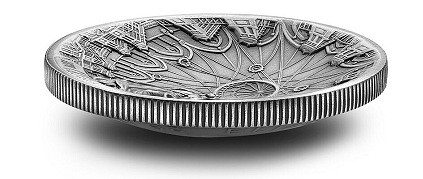
For more information on the 2016 140th Anniversary of the Library of Parliament Fine Silver Coin, please visit the Web site of the Royal Canadian Mint.
To read the complete article, see:
Canada Issues
First Concave Silver Coin Celebrating Library of Parliament
(http://world.mintnewsblog.com/2016/01/canada-issues-first-concave-silver-coin-celebrating-library-of-parliament/)
BANKNOTES OF THE BAHAMAS
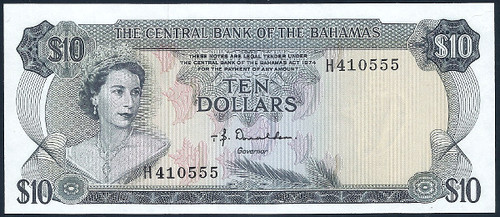
The Bahamas, now a popular tourist destination, are a group of islands located off the coast of Florida. Originally a British colony, the country became independent in 1973, but remained in the British Commonwealth with Queen Elizabeth II as head of state. The bank notes that we will focus on have been issued under the decimal system based on the dollar, introduced in 1966 (although the first notes were dated 1965, starting with Pick-17). Advanced collectors can decide to collect the earlier bank note issues of the Bahamas as well, first issued in 1919, which were denominated in pound sterling.
The Currency Note Act of 1965 introduced the decimal system to the Bahamas. Coins and bank notes denominated in cents and dollars (as opposed to pence, shillings, and pounds, as they had been in the past) were introduced in 1966. Old and new currency was in circulation concurrently for six months, after which time the old coins and bank notes were no longer legal tender.

The Bahamas government issued the new bank notes. A total of eight denominations were issued, all dated 1965: 1/2 dollar, 1 dollar, 3 dollars, 5 dollars, 10 dollars, 20 dollars, 50 dollars, and 100 dollars. Initially, the 5 dollar note was green, but after a year this color was changed to orange, to avoid confusion with the 1 dollar note, which was also green.
All three series have numerous notes that are scarce to rare. The ½ dollar, 1 dollar, and 3 dollar of each of the three dates are generally available in Uncirculated condition and are a good introduction to the bank notes of the Bahamas. The 5 dollar notes start to become scarce in Uncirculated condition, as are the 10 dollar and higher denominations. For each of the three series, the 50 dollar and 100 dollar notes are multi-thousand dollar rarities that are generally offered for sale only at major auctions. Some of the individual signature varieties are even more difficult, such as the 20 dollar note dated 1965 with three signatures, with no recent auction appearances of the better variety.
To read the complete article, see:
Collecting Bank Notes of the Bahamas (http://news.coinupdate.com/37724-2/)
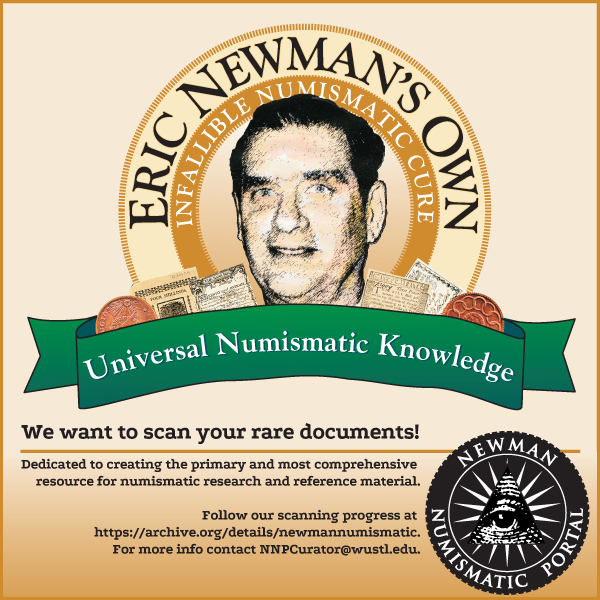
ANOTHER PHYSICAL BITCOIN PRODUCT
CoinReverse's marketing team has gone creative enough to attach a special gift to each and every transaction amounting more than 10 BTC: they are offering a 24-karat gold coin with the Bitcoin engraved on both sides. The mechanism is simple: each customer selling over 10 BTC within one transaction is asked to provide a mailing address and the company delivers the gift via a courier.
CoinReverse's Marketing Manager Jacob Gustavo is enthusiastic with their latest gift idea, while being positive that people involved in the cryptocurrency market are definitely welcoming a jewelry-like item engraved with the Bitcoin logo, being offered to them for doing business with CoinReverse.
"In this way, we are offering our customers a somehow materialized version of this virtual, non-material coin. We think it's pretty cool to put your hands on a coin carrying the Bitcoin's logo, especially if you're passionate about the cryptocurrencies," declares Jacob Gustavo, company's Marketing Manager.
Coin Reverse Inc. is a cryptocurrency trading company based in New York, USA.
To read the complete article, see:
Engraved Bitcoin Offered
to CoinReverse Customers (www.virtual-strategy.com/2016/01/28/engraved-bitcoin-offered-coinreverse-customers#axzz3ym2Smpvo)
To read the earlier E-Sylum articles, see:
U.S. GOVERNMENT SHUTS DOWN PHYSICAL BITCOIN MINTER
(www.coinbooks.org/esylum_v16n51a14.html)
MORE PHYSICAL BITCOINS (www.coinbooks.org/esylum_v16n52a18.html)
BLOOKS: THE ART OF BOOKS THAT AREN’T
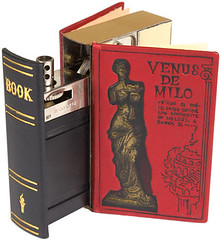 Mindell Dubansky’s romance with fake books began nearly two decades ago at a Manhattan flea market, where she picked up a small volume
carved from a piece of coal and bearing the name of a young man who had died in a mining accident in 1897.
Mindell Dubansky’s romance with fake books began nearly two decades ago at a Manhattan flea market, where she picked up a small volume
carved from a piece of coal and bearing the name of a young man who had died in a mining accident in 1897.
“An electric charge of grief went through my entire body,” Ms. Dubansky, the longtime preservation librarian at the Metropolitan Museum of Art, recalled.
A light bulb also went off in her head. Sensing an unexplored territory, Ms. Dubansky set out to map the contours of the world of fake books, eventually amassing about 600 made from stone, wax, straw, wood, soap, plastic, glass and other materials. She even coined a term for them: “blooks,” short for “book-look.”
Some 200 items from her collection went on display on Thursday at the Grolier Club in Manhattan, a temple to books, where they will remain through March 12. The exhibition, “Blooks: The Art of Books That Aren’t,” appears to be the first of its kind in the United States.
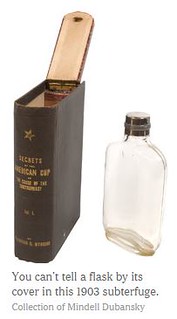

Most exhibitions at the Grolier, whose grand library holds more than 100,000 volumes with real pages and sometimes spectacular fine bindings, don’t include items like Secret Sam’s Spy Dictionary, a 1960s toy that lets users photograph enemies with a camera hidden inside a fake tome that also shoots plastic bullets out of its spine.
To Ms. Dubanksy, the larger goal of the show is to have fake books accepted as a real part of biblio-history.
“I see blooks as a parallel to book history, but I’ve had trouble getting people to take them seriously because of the association with kitsch,” she said.
While it can be hard to establish a clear history of blooks, they may have existed as long as the codex itself. There were elaborate medieval reliquaries shaped like books, as well as items like a book-shaped beer keg Ms. Dubansky saw described in an old text.
The Grolier show ranges chronologically from an 18th-century wooden volume that opens up into an altar (apparently used by Roman Catholics, Ms. Dubansky said) to a purple plastic children’s toy from the mid-1990s called a Polly Pocket. The objects in categories — religion, commemoration, photography, food, toys, grooming and so on — forming what Ms. Dubansky calls a tentative taxonomy of blooks.
It’s hard not to be charmed by the emotional intensity, inventiveness and sometimes sheer whimsy of the items in the chockablock display cases. In one, book-shaped boxes for office supplies sit near a delicate straw-work sewing kit, made by a French prisoner during the Napoleonic Wars. A display of mini-blooks includes a pocket clothes brush tucked inside a volume by “Y. B. Untidy.” A case dedicated to food includes book-shaped containers and promotional displays for biscuits, coffee and sardines. (Sardines?)
Among the hardest sub-collections to assemble, Ms. Dubansky said, was a case of corny gag books. These include a 1941 anti-baldness volume called “How to Save Your Hair” (inside: a plastic bag in which to place the strands that had fallen out) and several “exploding books” made by the novelty company S. S. Adams, better known for the whoopee cushion and joy buzzer.
“It took me years just to make this collection,” she said. “In their time they were very popular, but they were disposable.”
To read the complete article, see:
‘Blooks: The Art of Books That Aren’t’
Explores the World of Fake Books (www.nytimes.com/2016/01/29/books/a-secret-in-every-tome-no-text-required.html?_r=1)
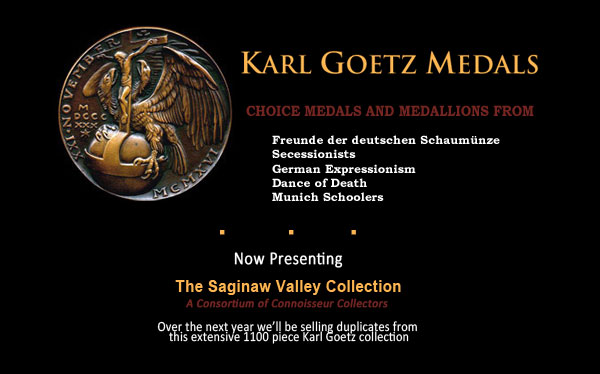
TREASURE SEARCH TURNS INTO HUNT FOR SEARCHER
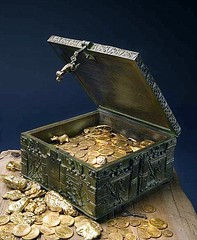 An antiquities dealer who inspired tens of thousands to search the Rocky Mountains for $2 million in hidden treasure now leads an
increasingly desperate mission to find one of his fans.
An antiquities dealer who inspired tens of thousands to search the Rocky Mountains for $2 million in hidden treasure now leads an
increasingly desperate mission to find one of his fans.
Forrest Fenn has been flying out in chartered helicopters or planes, searching remote stretches of the upper Rio Grande for any sign of Randy Bilyeu, now missing in the wild for more than three frigid weeks. Fellow treasure hunters also are searching for Bilyeu, who was last seen on Jan. 5 while trying to solve Fenn's mystery.
"Every time we go out and don't find Randy it's discouraging but we're not going to give up," Fenn told The Associated Press. "There are still places out there that I want to look."
Fenn, an eccentric 85-year-old from Santa Fe, has inspired a cult following since his announcement several years ago that he stashed a small bronze chest containing nearly $2 million in gold, jewelry and artifacts somewhere in the Rockies. He dropped clues to its whereabouts in a cryptic poem in his self-published memoir, "The Thrill of the Chase."
The hidden treasure has inspired thousands to search in vain through remote corners of New Mexico, Yellowstone National Park and elsewhere in the mountains. Treasure hunters share their experiences on blogs and brainstorm about the clues. The mystery has been featured by national media, igniting even more interest.
Fenn gets about 120 emails a day from people looking for his 40-pound box, and believes 65,000 people have searched for the stash, some using family vacations to venture into the woods.
"The hope of finding the treasure is one thing, of course, but there's a sense of adventure when you get out in the mountains and in the sunshine and the fresh air," Fenn explained. "One of my motives was to get the kids off the couch and away from the game machine."
But the search can be risky: Some have forded swollen creeks in Yellowstone and were rescued by rangers. A Texas woman spent a worrisome night in the New Mexico woods after being caught in the dark. Others have been cited for digging on public land, and federal managers have warned treasure hunters not to damage archaeological or biological resources.
No "Fenner" has been in a more dangerous a predicament than Bilyeu, a 54-year-old grandfather who moved to Colorado two years ago to follow this dream.
Family and friends say he bought a raft and set out on Jan. 5 after scouting for two weeks along the river west of Santa Fe. He had a GPS device, a wetsuit and waders, and brought along his little white dog, Leo.
More than a week passed before a worried friend reached out to his ex-wife in Florida, Linda Bilyeu, who filed a missing person's report on Jan. 14. His raft and dog were found the next day.
To read the complete article, see: Treasure hunter disappears searching for $2 million in gold (http://bigstory.ap.org/article/ff249fc3709146d280b66af5bf03f2c2/treasure-hunter-disappears-searching-2-million-gold)
To read the earlier E-Sylum article, see: TREASURE SEEKERS SEARCH FOR AUTHOR'S HIDDEN CHEST (www.coinbooks.org/esylum_v18n29a41.html)
CASH FOR YOUR WARHOL
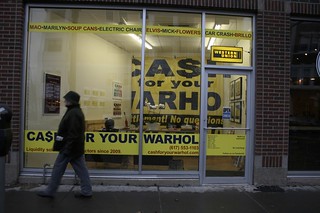 Inman Square in Cambridge, Massachusetts, is a quiet neighborhood that feels distant from the city’s universities, a good place to linger
in a café or browse through bookstores and antique shops. Last week, though, the square got a loud newcomer: an art project masquerading as a small
business, decked out in safety yellow and advertising “Cash For Your Warhol.”
Inman Square in Cambridge, Massachusetts, is a quiet neighborhood that feels distant from the city’s universities, a good place to linger
in a café or browse through bookstores and antique shops. Last week, though, the square got a loud newcomer: an art project masquerading as a small
business, decked out in safety yellow and advertising “Cash For Your Warhol.”
The store, nestled between a tony wine bar and a vegetarian fast-food stop, is insistently garish, festooned with signs that repeatedly shout its name and purpose. A thin banner across the top elaborates some common wares: “MAO / MARILYN / SOUP CANS / ELECTRIC CHAIR / ELVIS.” Inside, the joke continues, in the form of smaller jokes: oversized checks on the walls from successful purchases, and a board detailing the most sought-after works.
The back wall is covered by a vinyl sign so enormous that its edges have to be folded over, the slogan truncated into “AS FOR YOUR ARHO.” Overseeing it all is Geoff Hargadon–the energetic Somerville resident who, depending on your preferred narrative, serves either as company founder or artistic mastermind.
Hargadon, a financial planner by day, has been pretending to buy Warhols since 2009, when the recession spawned an influx of bandit signs promising ”Cash For Your Home” and “Cash For Your Gold.” Fascinated by the sheer bluntness of the signs, Hargadon started collecting them. At some point, while thinking about markets left untapped, “the phrase [Cash For Your Warhol] just popped into my head,” he says. He set up a hotline (617-553-1103), designed his own line of signs, stickers and billboards, and stuck them all over major cities from Kentucky to Pennsylvania.
The storefront, which opened in January 2016, is the latest incarnation of the project, which has also taken the form of several gallery shows and an installation outside Brandeis University’s Rose Art Museum, which at one point considered selling a portion of its collection. Now that it’s a brick-and-mortar operation, Cash For Your Warhol is even more public-facing. Hargadon threw a "totally packed" opening bash, and hosts visitors during irregular hours, which he announces on Twitter.
To read the complete article, see:
AN AFTERNOON AT
BOSTON'S NEWEST PARODY STOREFRONT, 'CASH FOR YOUR WARHOL'
(www.atlasobscura.com/articles/an-afternoon-at-bostons-newest-parody-storefront-cash-for-your-warhol)
THE UAE KFC GOLD COIN GIVEAWAY
 In celebration of the 50th anniversary of its original recipe in the GCC region, KFC - the world's number one name in chicken
restaurants - has plucked out the first 100 winners of the KFC's Gold Coins competition at their Jumeirah branch in Dubai. KFC will draw the
second group of lucky Gold Coin recipients next week.
In celebration of the 50th anniversary of its original recipe in the GCC region, KFC - the world's number one name in chicken
restaurants - has plucked out the first 100 winners of the KFC's Gold Coins competition at their Jumeirah branch in Dubai. KFC will draw the
second group of lucky Gold Coin recipients next week.
KFC diners in UAE 'Super Upsizing' on any of the meals in the promotion will be entered into a draw for the chance to win a real gold coin. Visitors to KFC restaurants in the country picking up any one of these 'Golden Meals' also have the chance to win a KFC Golden Card that entitles them to a free KFC meal every week for one year.
With over 700 branches across 75 cities in 12 countries in the region, KFC's Golden Jubilee campaign is aimed at providing the ultimate golden experience to its valued customers.

To read the complete article, see:
KFC names Gold Coin winners
(www.khaleejtimes.com/business/local/kfc-names-gold-coin-winners)
HIGHLAND MINT STRIKES SUPER BOWL 50 COINS
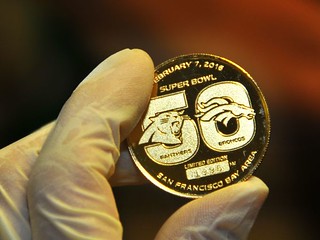 Friday was a big day for the Highland Mint. You could call it the "Super Bowl" of workdays. Why? Because the manufacturer of the
coin flipped prior to the start of the NFL's championship game was stamped, packaged and sent to the NFL for Super Bowl 50.
Friday was a big day for the Highland Mint. You could call it the "Super Bowl" of workdays. Why? Because the manufacturer of the
coin flipped prior to the start of the NFL's championship game was stamped, packaged and sent to the NFL for Super Bowl 50.
On Feb. 7, the Carolina Panthers will square off against the Denver Broncos in San Francisco in the Golden Anniversary of the Super Bowl. And that shiny, blingy one-ounce gold coin will determine which team will have the option to either kick off or receive the ball to start the game. Kickoff is set for 6:30 p.m.

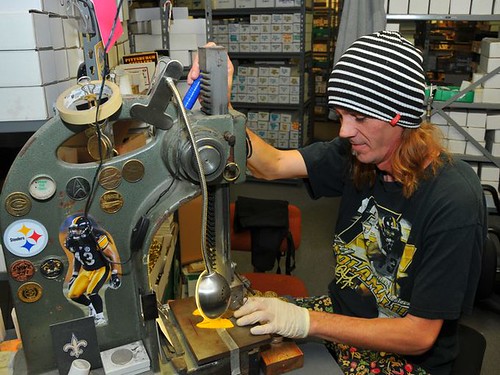
Highland Mint employee numbering Super Bowl 50 coins
Here are 5 things to know about the gold coin of Super Bowl 50.
1. "It's the first year that the Super Bowl logo is going to be heads and the side with the team logos is going to be tails," said Michael Kott, head of the Highland Mint. "Since it's the 50th Super Bowl, that's how the NFL decided to do it."
2. "In the past 49 years, it's been heads 24 times (meaning tails has come up 25 times.) So this year, based on statistics, it should be heads."
Fun fact: Four out of the past six teams that called the coin toss correctly ended up winning the Super Bowl, Kott added.
3. "It's the biggest prop bet they have," according to Timmy Vee of Coastal Hyundai. Vee, who is a friend of Kott's, has stamped serial No. 1 on the Super Bowl coin for the past 10 years. "There's over 350 prop bets on the Super Bowl, and the coin toss is the biggest one out of all of them. There's a lot of money made and lost when that thing flies up into the air."
4. "We make 10,000 (coins). The one with serial No. 1 is the one that's actually flipped at the game," according to Kott. That coin is then sent to the Pro Football Hall of Fame in Canton, Ohio.
5. "We also make a coin numbered with 0 on it," Kott said. "That they keep in case the game goes into overtime to see who's going to kick off. Luckily, that hasn't been used yet."
Besides making the flip coin for the start of the game, the Highland Mint also make a lot of products commemorating the two teams in the Super Bowl. One of the product lines is for the Super Bowl champions. About 30 minutes after the game ends, the Highland Mint starts production. "We already have the dyes made for the Carolina Panthers Super Bowl champions and the Denver Broncos Super Bowl Champions. Obviously, we use the one that wins, the other one gets destroyed," said Michael Kott, head of the Highland Mint.
Of course, this item is actually a medal and not a coin, but everybody is going to call it a coin. "Medal toss" just doesn't have the same ring. And nobody's going to call "Obverse!" or "Reverse!". Buy hey, why not yell "Obverse!" instead of "Omaha!" just once...
With the rule change over which side is "heads", will the officials get it right with millions of fans watching? Will sore losers protest that they should have won the call?
So, have there been any escapees from the melting pot? Surviving test strikes of the losing team's coin?
Have any of our readers been to the Pro Football Hall of Fame? How are the coins displayed? -Editor
To read the complete article, see:
5 things to know about the Super Bowl
50 gold coin (www.floridatoday.com/story/news/2016/01/29/super-bowl-2016-super-bowl-coin/79496502/)
FEATURED WEB SITE: MUSEUM OSCAR ROTY
This week's Featured Web Site is Fondation et du Musee Oscar Roty, the Museum of the work of French coin and medal artist Oscar Roty (1846-1911).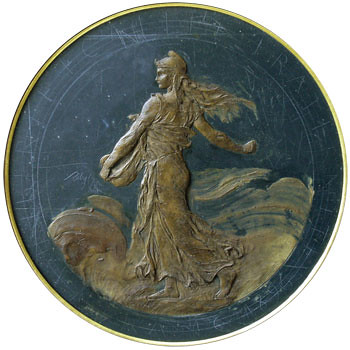
www.oscar-roty.fr

